Low Temperature District Heating: An Expert Opinion Survey
Abstract
1. Introduction
2. Materials and Methods
- Organization type (Q1.1). Different organization types were considered for the purpose of the analysis: (i) private and (ii) public companies, (iii) universities, (iv) private research centers, (v) authorities, (vi) self-employment operations, and (vii) other.
- Organization location (Q1.2). This information was considered essential to characterize participants’ opinions as a function of country and thus to recognize differences.
- Expertise area within the organization (Q1.3). Depending on the expertise area within the organization, different opinions were expected. Participants were asked to select one among: (i) energy planning, (ii) R&D, (iii) technical design, (iv) management, (v) business development, (vi) administrative/legal/authoritative, and (vii) other.
- Expertise area in district heating (Q1.4). Because differences in expertise area were possible, specifically regarding DH, participants were asked to specify it.
- Experience in DH sector (Q1.5). Participants’ experience is proportional to the expected knowledge of the DH sector. Four options were proposed: (i) less than 2 years, (ii) between 2 and 5 years, (iii) between 5 and 10 years, and (iv) more than 10 years.
- Awareness about the LTDH concept (Q2.1). Two possible answers were given. Regarding participants that had never heard about the LTDH concept, the survey was designed to omit their answers about the LTDH concept.
- First temporal awareness of the LTDH concept (Q2.2). This question was introduced to recognize the temporal evolution of the 4th generation of the DH sector. For this purpose, four possible answers were suggested: (i) before 2000, (ii) between 2000 and 2010, (iii) between 2010 and 2017, and (iv) this year, i.e., in 2018.
- First approach communication channels (Q2.3). With the received answers, it was possible to identify the dissemination potential and thus to give suggestions for future improvement. The following options were suggested: (i) sector conference/seminar/workshop, (ii) peer-reviewed papers, (iii) technical magazines/newspapers, (iv) internet sites, (v) plant visits, and (vi) other.
- Disadvantages of the existing DH systems with respect to conventional individual heating systems installed in the buildings (Q3.2). As for advantages, disadvantages were also selected based on those reported in the literature.
- Advantages of LTDH systems with respect to traditional DH systems (Q3.3). Regarding traditional DH systems, the proposed options were identified based on those reported in literature.
- Disadvantages of LTDH systems with respect to traditional DH systems (Q3.4).
- LTDH barriers’ ranking (Q3.5). Participants were asked to give a rank between 1 (very low importance) and 5 (very high importance) to several technical, economic, and other barriers that could obstruct LTDH market development.
- Market development of the LTDH concept (Q3.6). Experts were asked to comment on the diffusion of the LTDH concept over the next 20 years.
3. Results and Discussion
3.1. Identification of Participants’ Status
3.2. The First Approach to the LTDH Concept
3.3. Experts’ Opinions about Traditional DH Systems: Strengths and Weaknesses with Respect to Individual Heating Systems
3.4. Experts’ Opinions about LTDH Systems: Strengths and Weaknesses with Respect to Traditional DH Systems
3.5. Experts’ Opinions about LTDH Systems: What Is the Importance of the Proposed Barriers with Respect to the Implementation of the LTDH Concept
3.6. Experts’ Opinions about the Diffusion of the LTDH Concept in Next Twenty Years
3.7. Experts’ Open Considerations about LTDH
- Economic considerations.
- Because of the technical and economic limitations in the retrofit of existing DH networks, the LTDH approach can be more easily applied in new DH networks. Given that it is reasonable to expect a higher number of new DH projects where a low DH penetration is currently present, LTDH vision seems to have the greatest potential in these areas.
- A reduction of the initial investment would be possible if both heating and cooling demands were supplied with a single energy distribution network.
- Legislative, regulatory, and incentive strategies have to be promulgated by national governments to promote the implementation of LTDH systems. In fact, thermal loss reduction is not sufficient to justify the investment and secure a low pay back period.
- Technical considerations—concerns about the need to design larger diameter pipelines to supply high thermal demands in LTDH systems with respect to traditional DH systems.
- Regardless of opinion, as shown in [26], the LTDH network requires a higher flow rate in comparison with traditional district heating only in the case that heat and cooling demands are not balanced.
- Furthermore, a reduction of the heating demands to be supplied by the networks is ensured by the heat pumps installed in DH substations. At the evaporator site, in fact, a reduction factor equal to (COP-1)/(COP), where COP is the coefficient of performance of the heat pump, has to be applied.
- Service reliability and redundancy.
- Based on the presence of prosumers, whose behavior cannot be completely controlled by DH operators, some backup or integration devices have to be considered in the design phase.
- Heat storage volumes should be considered when heat production and consumption cannot be contemporary. For this purpose, sensible or latent heat storage technologies can be evaluated in accordance with the work of [68].
4. Conclusions
- Communication channels. Sector conferences, seminars, and workshops represent the most preferred communication channels by the interviewed participants. Only few participants recognized other communication channels, such as peer-reviewed papers and plant visits.
- Advantages of traditional DH systems with respect to individual heating systems. Participants agreed to the fact that higher efficiency and technology reliability are the most important. Only a small percentage of participants attributed importance to business profitability or to technology replicability.
- Disadvantages of traditional DH systems with respect to individual heating systems. From the reported answers, it is clear that the high distribution thermal losses were the most important disadvantage of traditional DH. The influence of external conditions on the DH business model is also considered by some as a critical point for technology implementation.
- Advantages of the LTDH approach with respect to traditional DH systems. Almost all the participants agreed to the fact that LTDH ensures a reduction of distribution heat losses and less complexity in the integration of renewable sources at generation plants. Only a small percentage of Italian participants believed that the higher environmental and energy performances represent an important advantage. Consequently, the Italian authorities should propose promotion actions to compel sector stakeholders to improve energy and environmental performances.
- Disadvantages of the LTDH approach with respect to traditional DH systems. To accelerate the transition to LTDH systems, dedicated actions have to be taken. First of all, current DH business models need to be changed in order to be applied to LTDH systems, ensuring profitability. Secondly, dedicated technological solutions are required to ensure existing supply conditions, especially in the case of network retrofitting.
- Ranking of the barriers against the implementation of LTDH. It seems that Italian rankings were on average lower than those received from other participants. That is, the most important barriers were the need to modify existing business models, the high investment cost, the limited opportunities for existing substation retrofitting, and the contractual restrictions about supply temperature. A different opinion about the suggested lack of competence for the implementation of LTDH systems was found between Italian and other participants.
- Diffusion of the LTDH concept in the next 20 years. Despite the need to move in an LTDH direction to ensure energy and decarbonization goals, only participants from other countries believed that a good diffusion would be possible in the next 20 years; for Italian participants, a poor diffusion of the LTDH concept was expected. This opinion can be justified by the fact that Italian DH plants are of recent construction and in most cases not yet completely amortized. In addition to this, the low renovation rate of existing Italian buildings compels managers to believe that high temperature supply is still necessary to ensure contractual supply conditions [51].
- dedicated business models to the LTDH concept based on the prosumers concept and on the modification of the existing energy self-consumption model in Italian regulatory frameworks;
- innovative and high efficiency devices able to locally boost the supply temperature at the values required by contract and able to be installed in available spaces;
- identification of the best control strategies to manage LTDH systems in the case of contemporary heating and cooling demands.
Author Contributions
Funding
Acknowledgments
Conflicts of Interest
Appendix A
| The Survey Questions | |
|---|---|
| Part 1: Professional Status | 1.1 In what of the following organizations do you work? |
| 1.2 In which country is your organization located? | |
| 1.3 What is your expertise area within the organization? | |
| 1.4 What is your expertise area in district heating? | |
| 1.5 How long do you work in the district heating sector? | |
| Part 2: LTDH: The First Approach | 2.1 Have you ever heard about “low temperature district heating”? |
| 2.2 When do you hear about the concept of “low temperature district heating” for the first time? | |
| 2.3 Through which channel do you hear about the concept of “low temperature district heating” for the first time? | |
| Part 3: LTDH: Your Opinion | 3.1 In your opinion, what are the main advantages of existing traditional district heating systems? |
| 3.2 In your opinion, what are the main disadvantages of existing traditional district heating systems? | |
| 3.3 In your opinion, what are the main advantages of the low temperature district heating plants in comparison with traditional ones? | |
| 3.4 In your opinion, what are the main disadvantages of the low temperature district heating plants in comparison with traditional ones? | |
| 3.5 Are you able to rank the following barriers to adapt traditional district heating systems to “low temperature district heating systems? | |
| 3.6 What future do you expect for low-temperature district heating systems in your country? | |
| 3.7 Please, can you leave a comment about low temperature district heating systems? | |
| Suggested Answers to the Expert Opinion Survey | |
|---|---|
| Question 1.1 | □ Public company □ Private company □ Private research center □ University □ Public Authority □ Self-employed □ Other |
| Question 1.2 | Any country in the world is permitted as an answer. |
| Question 1.3 | □ Administrative/Legal/Authorization □ Business development □ Energy planning □ Management □ Research and development □ Technical/Design □ Other |
| Question 1.4 | Answers are equal to those for Question 1.3. |
| Question 1.5 | □ Less than 2 years □ Between 2 years and 5 years □ Between 5 years and 10 years □ More than 10 years |
| Question 2.1 | □ Yes □ No (*) |
| Question 2.2 | □ Before 2000 □ Between 2000-2010 □ Between 2010-2017 □ This year |
| Question 2.3 (**) | □ Sector conference/seminar/workshop □ Peer-reviewed papers □ Technical magazines/newspapers □ Internet sites □ Plant visits □ Other |
| Question 3.1 (**) | □ State-of-the-art technology/Reliability □ Remunerative business model □ Able to supply heat to new and existing buildings □ Higher efficiency with respect to traditional decentralized plants □ High replicability □ Other |
| Question 3.2 (**) | □ Complex integration of renewable energy sources in the generation plant □ High distribution heat losses □ Business model influenced by several external factors such as fuel cost, electricity selling price and incentives/Feed-in tariffs □ High limitations to decentralized energy production (at customer level) □ Environmental sustainability □ High heating selling price □ Technical and/or economic limitations for the integration with district cooling systems □ Other |
| Question 3.3 (**) | □ Reduction of distribution heat losses □ Lower complexity in the integration of renewable energy sources at the generation plant □ Lower complexity in the integration of renewable energy sources at the customer level □ Reduction of operative costs □ Higher environmental sustainability □ Higher energy efficiency □ Higher integration in district cooling systems □ Other |
| Question 3.4 (**) | □ Business model still to be developed □ Higher investment costs □ The need to locally boost supply temperature depending on customer’s characteristics (i.e., old/new buildings) □ More complex management of central heat production and distribution □ More complex management of the overall system due to distributed energy production required also at the customer level □ Need to meter thermal energy fluxes to and from the network □ The need to locally boost supply temperature for domestic hot water production □ Other |
| Question 3.5 (***) | □ High investment costs □ The need to locally boost supply temperature □ The need to modify existing business models □ The metering of the thermal energy fluxes to and from the network □ Contractual restrictions about supply temperature conditions □ Limited opportunities for existing substation retrofitting □ The relationship with the customer □ Legislative/Regulatory/Authorization constraints □ Conflictual relationship between the grid operator, the district heating plant manager and the eventual manager of the substation □ Lack of the required technical competences □ Other |
| Question 3.6 | □ None □ Poor diffusion in the next 20 years □ Good diffusion in the next 20 years □ Market penetration already in place with good diffusion □ I don’t know |
| Question 3.7 | Open form answer |
References
- Ekins, P. Step changes for decarbonising the energy system: Research needs for renewables, energy efficiency and nuclear power. Energy Policy 2004, 32, 1891–1904. [Google Scholar] [CrossRef]
- BP Energy Economics. 2018 BP Energy Outlook; BP p.l.c.: London, UK, 2018. [Google Scholar]
- Connolly, D.; Lund, H.; Mathiesen, B.V.; Werner, S.; Möller, B.; Persson, U.; Boermans, T.; Trier, D.; Østergaard, P.A.; Nielsen, S. Heat Roadmap Europe: Combining district heating with heat savings to decarbonise the EU energy system. Energy Policy 2013, 65, 475–489. [Google Scholar] [CrossRef]
- Cassitto, L. District heating systems in Europe. A review. Resour. Conserv. Recycl. 1990, 4, 271–281. [Google Scholar] [CrossRef]
- Sayegh, M.A.; Danielewicz, J.; Nannou, T.; Miniewicz, M.; Jadwiszczak, P.; Piekarska, K.; Jouhara, H. Trends of European research and development in district heating technologies. Renew. Sustain. Energy Rev. 2017, 68, 1183–1192. [Google Scholar] [CrossRef]
- Lake, A.; Rezaie, B.; Beyerlein, S. Review of district heating and cooling systems for a sustainable future. Renew. Sustain. Energy Rev. 2017, 67, 417–425. [Google Scholar] [CrossRef]
- Rezaie, B.; Rosen, M.A. District heating and cooling: Review of technology and potential enhancements. Appl. Energy 2012, 93, 2–10. [Google Scholar] [CrossRef]
- Li, H.; Svendsen, S. Energy and exergy analysis of low temperature district heating network. Energy 2012, 45, 237–246. [Google Scholar] [CrossRef]
- Bianchini, A.; Guzzini, A.; Pellegrini, M.; Saccani, C. Natural gas distribution system: A statistical analysis of accidents data. Int. J. Press. Vessel. Pip. 2018, 168, 24–38. [Google Scholar] [CrossRef]
- Werner, S. International review of district heating and cooling. Energy 2017, 137, 617–631. [Google Scholar] [CrossRef]
- Lund, R.; Persson, U. Mapping of potential heat sources for heat pumps for district heating in Denmark. Energy 2016, 110, 129–138. [Google Scholar] [CrossRef]
- Lauka, D.; Gusca, J.; Blumberga, D. Heat Pumps Integration Trends in District Heating Networks of the Baltic States. Procedia Comput. Sci. 2015, 52, 835–842. [Google Scholar] [CrossRef]
- Averfalk, H.; Ingvarsson, P.; Persson, U.; Gong, M.; Werner, S. Large heat pumps in Swedish district heating systems. Renew. Sustain. Energy Rev. 2017, 79, 1275–1284. [Google Scholar] [CrossRef]
- Ericsson, K.; Werner, S. The introduction and expansion of biomass use in Swedish district heating systems. Biomass Bioenergy 2016, 94, 57–65. [Google Scholar] [CrossRef]
- Soltero, V.M.; Chacartegui, R.; Ortiz, C.; Velázquez, R. Potential of biomass district heating systems in rural areas. Energy 2018, 156, 132–143. [Google Scholar] [CrossRef]
- Vallios, I.; Tsoutsos, T.; Papadakis, G. Design of biomass district heating systems. Biomass Bioenergy 2009, 33, 659–678. [Google Scholar] [CrossRef]
- Reiter, P.; Poier, H.; Holter, C. BIG Solar Graz: Solar District Heating in Graz—500,000 m2 for 20% Solar Fraction. Energy Procedia 2016, 91, 578–584. [Google Scholar] [CrossRef]
- Best, I.; Orozaliev, J.; Vajen, K. Economic comparison of low-temperature and ultra-low-temperature district heating for new building developments with low heat demand densities in Germany. Int. J. Sustain. Energy Plan. Manag. 2018, 16, 45–60. [Google Scholar]
- Gudmundsson, O.; Thorsen, J.E.; Zhang, L. Cost analysis of district heating compared to. Trans. Ecol. Environ. 2013, 176, 1743–3541. [Google Scholar]
- Reidhav, C.; Werner, S. Profitability of sparse district heating. Appl. Energy 2008, 85, 867–877. [Google Scholar] [CrossRef]
- Comodi, G.; Lorenzetti, M.; Salvi, D.; Arteconi, A. Criticalities of district heating in Southern Europe: Lesson learned from a CHP-DH in Central Italy. Appl. Therm. Eng. 2017, 112, 649–659. [Google Scholar] [CrossRef]
- Lund, H.; Werner, S.; Wiltshire, R.; Svendsen, S.; Thorsen, J.E.; Hvelplund, F.; Mathiesen, B.V. 4th Generation District Heating (4GDH): Integrating smart thermal grids into future sustainable energy systems. Energy 2014, 68, 1–11. [Google Scholar] [CrossRef]
- Averfalk, H.; Werner, S.; Felsmann, C.; Ruhling, K.; Wiltshire, R.; Svendsen, S. Annex XI Final Report. Transformation Roadmap from High to Low Temperature District Heating Systems; IEA: Paris, France, 2017. [Google Scholar]
- Lund, R.; Østergaard, D.S.; Yang, X.; Mathiesen, B.V. Comparison of Low-temperature District Heating Concepts in a Long-Term Energy System Perspective. Int. J. Sustain. Energy Plan. Manag. 2017, 12, 5–18. [Google Scholar]
- Colmenar-Santos, A.; Rosales-Asensio, E.; Borge-Diez, D.; Blanes-Peiró, J.-J. District heating and cogeneration in the EU-28: Current situation, potential and proposed energy strategy for its generalisation. Renew. Sustain. Energy Rev. 2016, 62, 621–639. [Google Scholar] [CrossRef]
- Pellegrini, M.; Bianchini, A. The innovative concept of cold district heating networks: A literature review. Energies 2018, 11, 236. [Google Scholar] [CrossRef]
- Schmidt, D.; Kallert, A.; Blesl, M.; Li, H.; Svendsen, S.; Nord, N.; Sipilä, K.; Rämä, M.; Gudmundson, O.; Kuosa, M.; et al. DHC Annex TS1—Low Temperature District Heating for Future Energy Systems; AGFW-Project Company: Frankfurt am Main, Germany, 2017; ISBN 3899990706. [Google Scholar]
- De Uribarri, P.M.Á.; Eicker, U.; Robinson, D. Energy performance of decentralized solar thermal feed-in to district heating networks. Energy Procedia 2017, 116, 285–296. [Google Scholar] [CrossRef]
- Parida, B.; Iniyan, S.; Goic, R. A review of solar photovoltaic technologies. Renew. Sustain. Energy Rev. 2011, 15, 1625–1636. [Google Scholar] [CrossRef]
- Bianchini, A.; Gambuti, M.; Pellegrini, M.; Saccani, C. Performance analysis and economic assessment of different photovoltaic technologies based on experimental measurements. Renew. Energy 2016, 85, 1–11. [Google Scholar] [CrossRef]
- Ni, L.; Dong, J.; Yao, Y.; Shen, C.; Qv, D.; Zhang, X. A review of heat pump systems for heating and cooling of buildings in China in the last decade. Renew. Energy 2015, 84, 30–45. [Google Scholar] [CrossRef]
- Tian, Y.; Zhao, C.Y. A review of solar collectors and thermal energy storage in solar thermal applications. Appl. Energy 2013, 104, 538–553. [Google Scholar] [CrossRef]
- Bianchini, A.; Guzzini, A.; Pellegrini, M.; Saccani, C. Performance assessment of a solar parabolic dish for domestic use based on experimental measurements. Renew. Energy 2019, 133, 382–392. [Google Scholar] [CrossRef]
- Chow, T.T. A review on photovoltaic/thermal hybrid solar technology. Appl. Energy 2009, 87, 365–379. [Google Scholar] [CrossRef]
- Bianchini, A.; Guzzini, A.; Pellegrini, M.; Saccani, C. Photovoltaic/thermal (PV/T) solar system: Experimental measurements, performance analysis and economic assessment. Renew. Energy 2017, 111, 543–555. [Google Scholar] [CrossRef]
- Dalla Rosa, A.; Li, H.; Svendsen, S.; Werner, S.; Persson, U.; Ruehling, K.; Felsmann, C.; Crane, M.; Burzynski, R.; Bevilacqua, C. Annex X Final Report. Toward 4th Generation District Heating: Experience and Potential of Low-Temperatur District Heating; IEA: Paris, France, 2014. [Google Scholar]
- Lund, H.; Østergaard, P.A.; Connolly, D.; Mathiesen, B.V. Smart energy and smart energy systems. Energy 2017, 137, 556–565. [Google Scholar] [CrossRef]
- Østergaard, D.S.; Svendsen, S. Replacing critical radiators to increase the potential to use low-temperature district heating—A case study of 4 Danish single-family houses from the 1930s. Energy 2016, 110, 75–84. [Google Scholar] [CrossRef]
- Østergaard, D.; Svendsen, S. Space heating with ultra-low-temperature district heating—A case study of four single-family houses from the 1980s. Energy Procedia 2017, 116, 226–235. [Google Scholar] [CrossRef]
- Brand, L.; Calvén, A.; Englund, J.; Landersjö, H.; Lauenburg, P. Smart district heating networks—A simulation study of prosumers’ impact on technical parameters in distribution networks. Appl. Energy 2014, 129, 39–48. [Google Scholar] [CrossRef]
- Brange, L.; Englund, J.; Lauenburg, P. Prosumers in district heating networks—A Swedish case study. Appl. Energy 2016, 164, 492–500. [Google Scholar] [CrossRef]
- Mathiesen, B.V.; Lund, H.; Connolly, D.; Wenzel, H.; Ostergaard, P.A.; Möller, B.; Nielsen, S.; Ridjan, I.; KarnOe, P.; Sperling, K.; et al. Smart Energy Systems for coherent 100% renewable energy and transport solutions. Appl. Energy 2015, 145, 139–154. [Google Scholar] [CrossRef]
- Lund, H.; Connolly, D.; Ostergaard, P.A.; Ridjan, I.; Vad Mathiesen, B.; Hvelplund, F.; Thellufsen, J.Z.; Sorknaes, P. Energy storage and Smart Energy Systems. Int. J. Sustain. Energy Plan. Manag. 2016, 11. [Google Scholar]
- Nord, N.; Løve Nielsen, E.K.; Kauko, H.; Tereshchenko, T. Challenges and potentials for low-temperature district heating implementation in Norway. Energy 2018, 151, 889–902. [Google Scholar] [CrossRef]
- Li, H.; Wang, S.J. Challenges in Smart Low-temperature District Heating Development. Energy Procedia 2014, 61, 1472–1475. [Google Scholar] [CrossRef]
- Gadd, H.; Werner, S. Fault detection in district heating substations. Appl. Energy 2015, 157, 51–59. [Google Scholar] [CrossRef]
- Xue, P.; Zhou, Z.; Fang, X.; Chen, X.; Liu, L.; Liu, Y.; Liu, J. Fault detection and operation optimization in district heating substations based on data mining techniques. Appl. Energy 2017, 205, 926–940. [Google Scholar] [CrossRef]
- Averfalk, H.; Werner, S. Novel low temperature heat distribution technology. Energy 2018, 145, 526–539. [Google Scholar] [CrossRef]
- Yang, X.; Li, H.; Svendsen, S. Evaluations of different domestic hot water preparing methods with ultra-low-temperature district heating. Energy 2016, 109, 248–259. [Google Scholar] [CrossRef]
- Yang, X.; Li, H.; Svendsen, S. Decentralized substations for low-temperature district heating with no Legionella risk, and low return temperatures. Energy 2016, 110, 65–74. [Google Scholar] [CrossRef]
- Pellegrini, M.; Bianchini, A.; Guzzini, A.; Saccani, C. Classification through analytic hierarchy process of the barriers in the revamping of traditional district heating networks into low temperature district heating: An Italian case study. Int. J. Sustain. Energy Plan. Manag. 2019, 20, 51–66. [Google Scholar]
- Astiaso Garcia, D.; Barbanera, F.; Cumo, F.; Di Matteo, U.; Nastasi, B.; Astiaso Garcia, D.; Barbanera, F.; Cumo, F.; Di Matteo, U.; Nastasi, B. Expert Opinion Analysis on Renewable Hydrogen Storage Systems Potential in Europe. Energies 2016, 9, 963. [Google Scholar] [CrossRef]
- Catenacci, M.; Verdolini, E.; Bosetti, V.; Fiorese, G. Going electric: Expert survey on the future of battery technologies for electric vehicles. Energy Policy 2013, 61, 403–413. [Google Scholar] [CrossRef]
- Bosetti, V.; Catenacci, M.; Fiorese, G.; Verdolini, E. The future prospect of PV and CSP solar technologies: An expert elicitation survey. Energy Policy 2012, 49, 308–317. [Google Scholar] [CrossRef]
- Fiorese, G.; Catenacci, M.; Verdolini, E.; Bosetti, V. Advanced biofuels: Future perspectives from an expert elicitation survey. Energy Policy 2013, 56, 293–311. [Google Scholar] [CrossRef]
- Maestas, C. Expert Surveys as a Measurement Tool: Challenges and New Frontiers; Atkeson, L.R., Alvarez, R.M., Eds.; Oxford University Press: Oxford, UK, 2016; Volume 1. [Google Scholar]
- Eraut, M. Expert and Expertise: Meanings and Perspectives. Learn. Health Soc. Care 2005, 4, 173–179. [Google Scholar] [CrossRef]
- Çomaklı, K.; Yüksel, B.; Çomaklı, Ö. Evaluation of energy and exergy losses in district heating network. Appl. Therm. Eng. 2004, 24, 1009–1017. [Google Scholar] [CrossRef]
- Nuytten, T.; Claessens, B.; Paredis, K.; Van Bael, J.; Six, D. Flexibility of a combined heat and power system with thermal energy storage for district heating. Appl. Energy 2013, 104, 583–591. [Google Scholar] [CrossRef]
- Rämä, M.; Wahlroos, M. Introduction of new decentralised renewable heat supply in an existing district heating system. Energy 2018, 154, 68–79. [Google Scholar] [CrossRef]
- Pirouti, M.; Bagdanavicius, A.; Ekanayake, J.; Wu, J.; Jenkins, N. Energy consumption and economic analyses of a district heating network. Energy 2013, 57, 149–159. [Google Scholar] [CrossRef]
- Olsthoorn, D.; Haghighat, F.; Mirzaei, P.A. Integration of storage and renewable energy into district heating systems: A review of modelling and optimization. Sol. Energy 2016, 136, 49–64. [Google Scholar] [CrossRef]
- Persson, U.; Werner, S. Heat distribution and the future competitiveness of district heating. Appl. Energy 2011, 88, 568–576. [Google Scholar] [CrossRef]
- Rosada, J. Characteristics of District Heating-Advantages and Disadvantages. Energy Build. 1988, 12, 163–171. [Google Scholar] [CrossRef]
- Schuman, H.; Presser, S. The Open and Closed Question. Am. Sociol. Rev. 1979, 44, 692. [Google Scholar] [CrossRef]
- Züll, C. Open-Ended Questions. GESIS Survey Guidelines; GESIS—Leibniz Institute for the Social Sciences: Mannheim, Germany, 2016. [Google Scholar]
- Lund, H.; Østergaard, P.A.; Chang, M.; Werner, S.; Svendsen, S.; Sorknæs, P.; Thorsen, J.E.; Hvelplund, F.; Mortensen, B.O.G.; Mathiesen, B.V.; et al. The status of 4th generation district heating: Research and results. Energy 2018, 164, 147–159. [Google Scholar] [CrossRef]
- Flores, J.; Espagnet, A.; Chiu, J.; Martin, V.; Lacarriere, B. Techno-Economic Assessment of Active Latent Heat Thermal EnergyStorage Systems with Low-Temperature District Heating. Int. J. Sustain. Energy Plan. Manag. 2017, 13, 5–18. [Google Scholar]
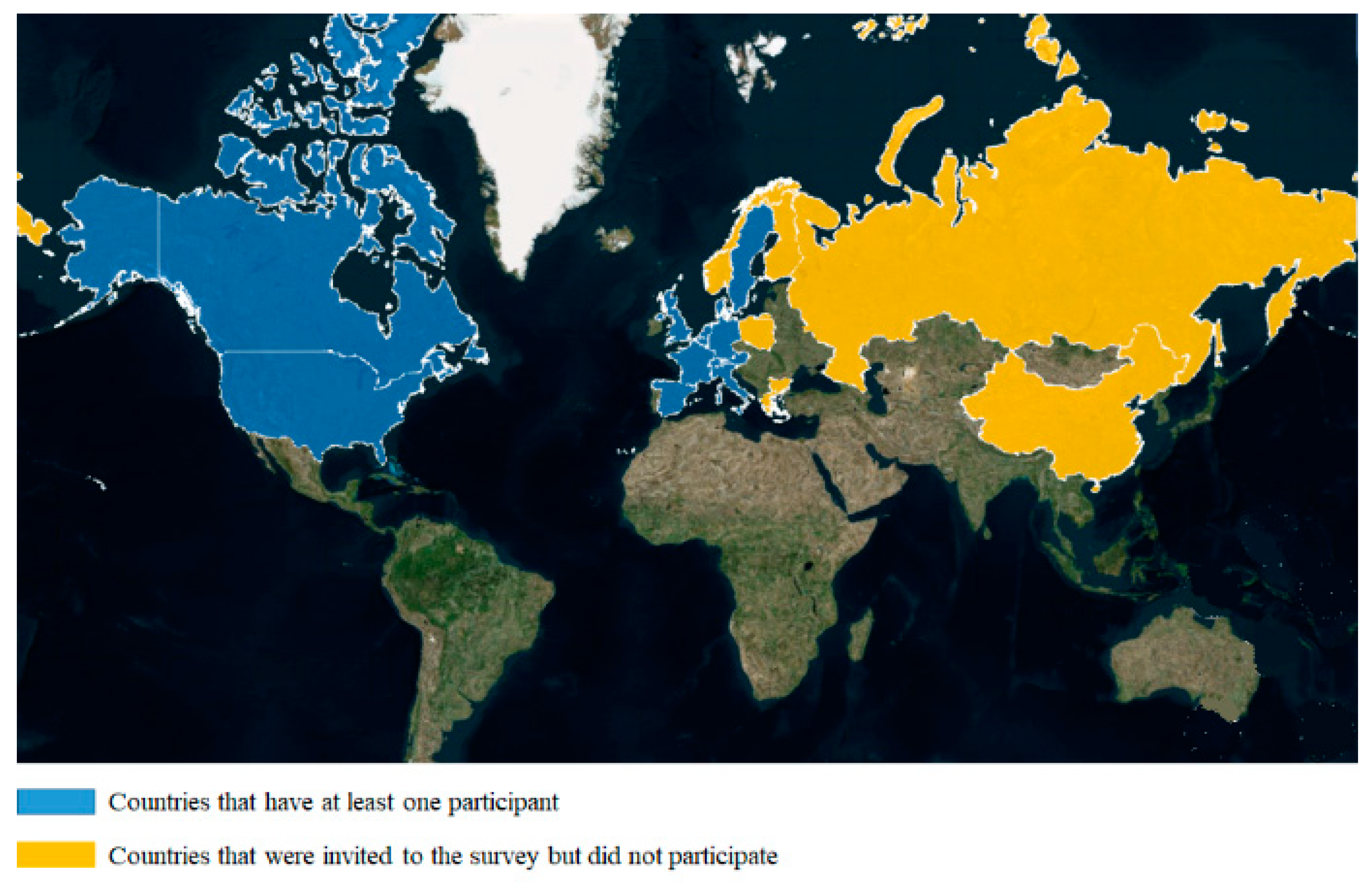
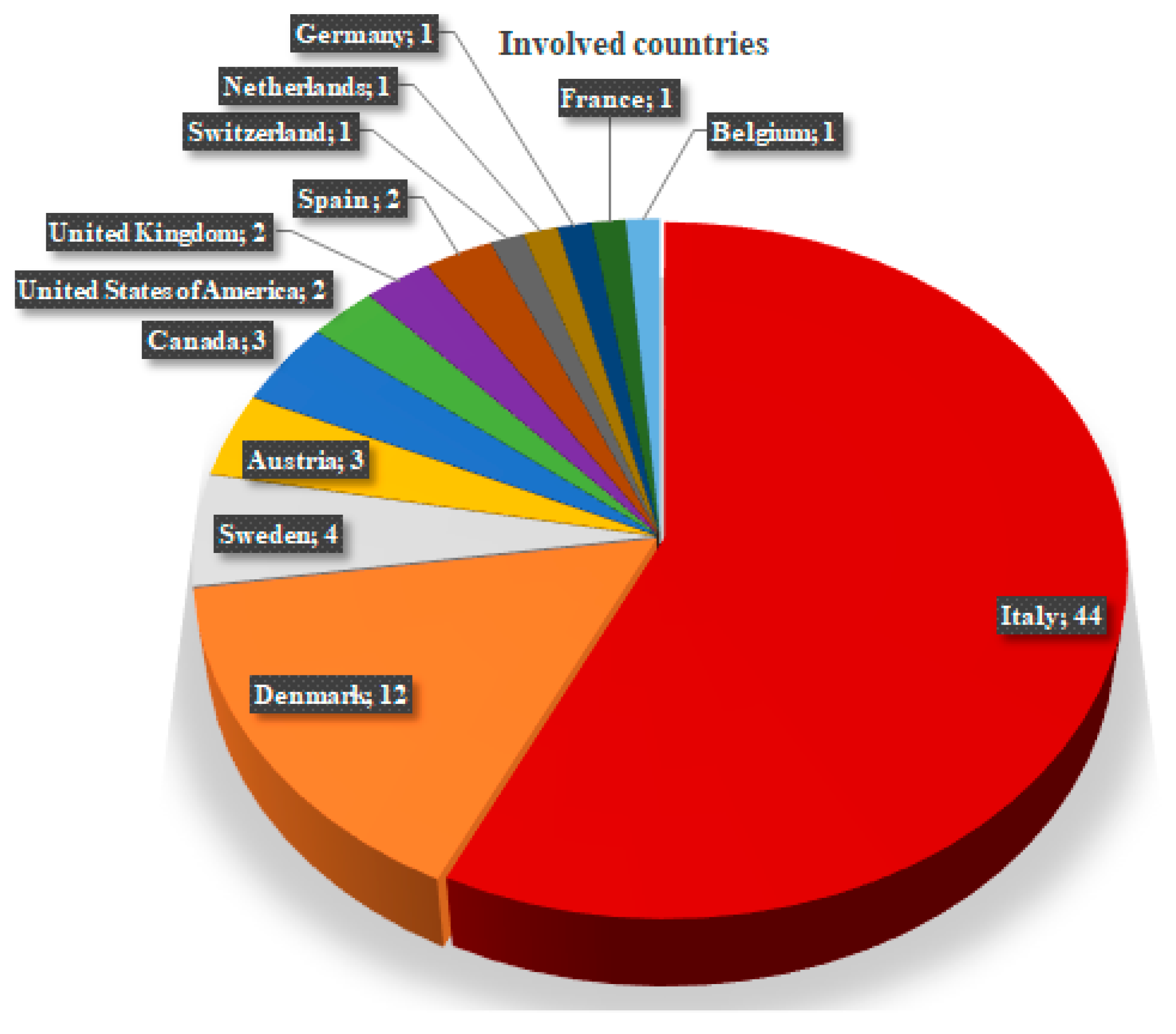
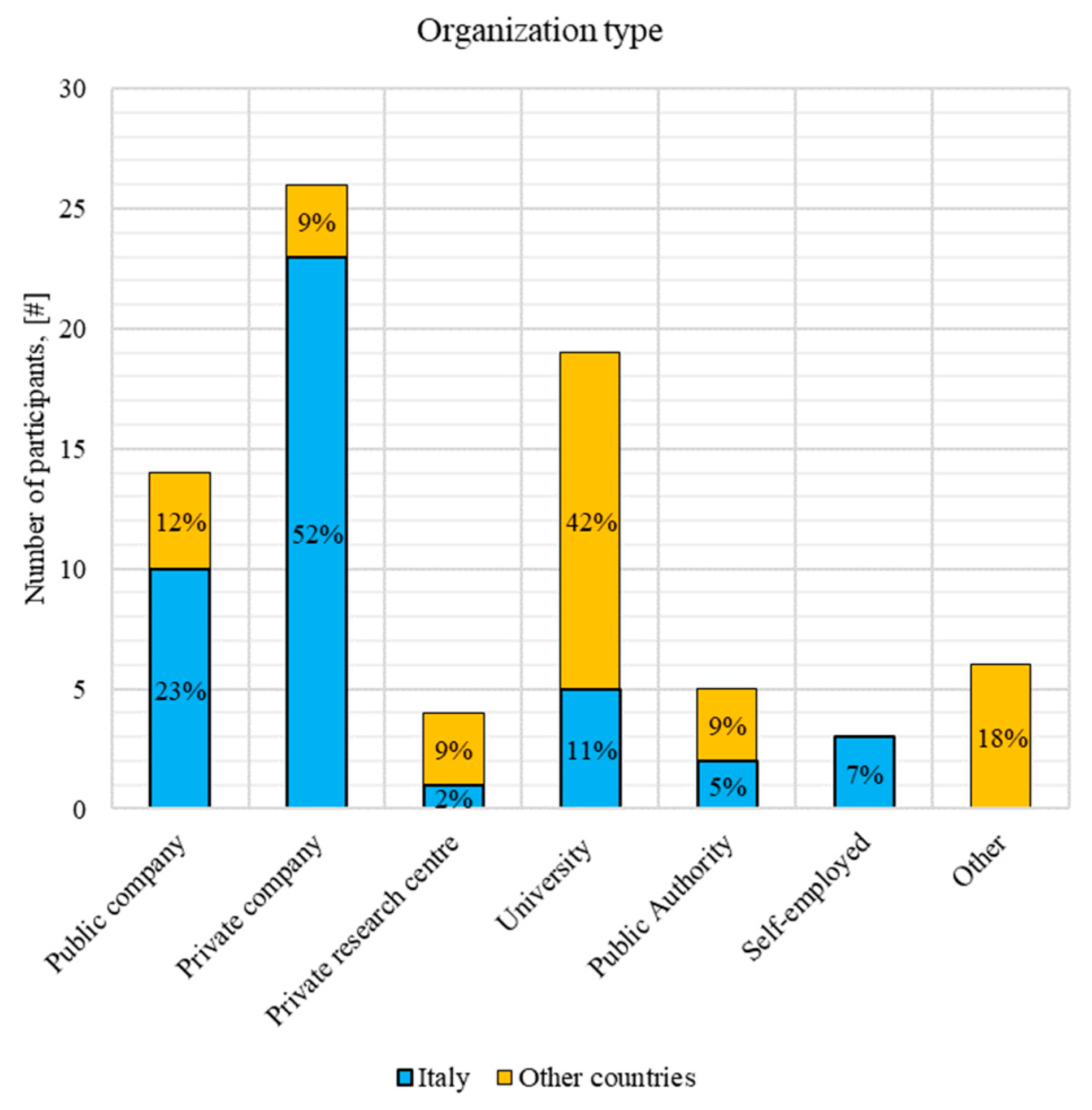
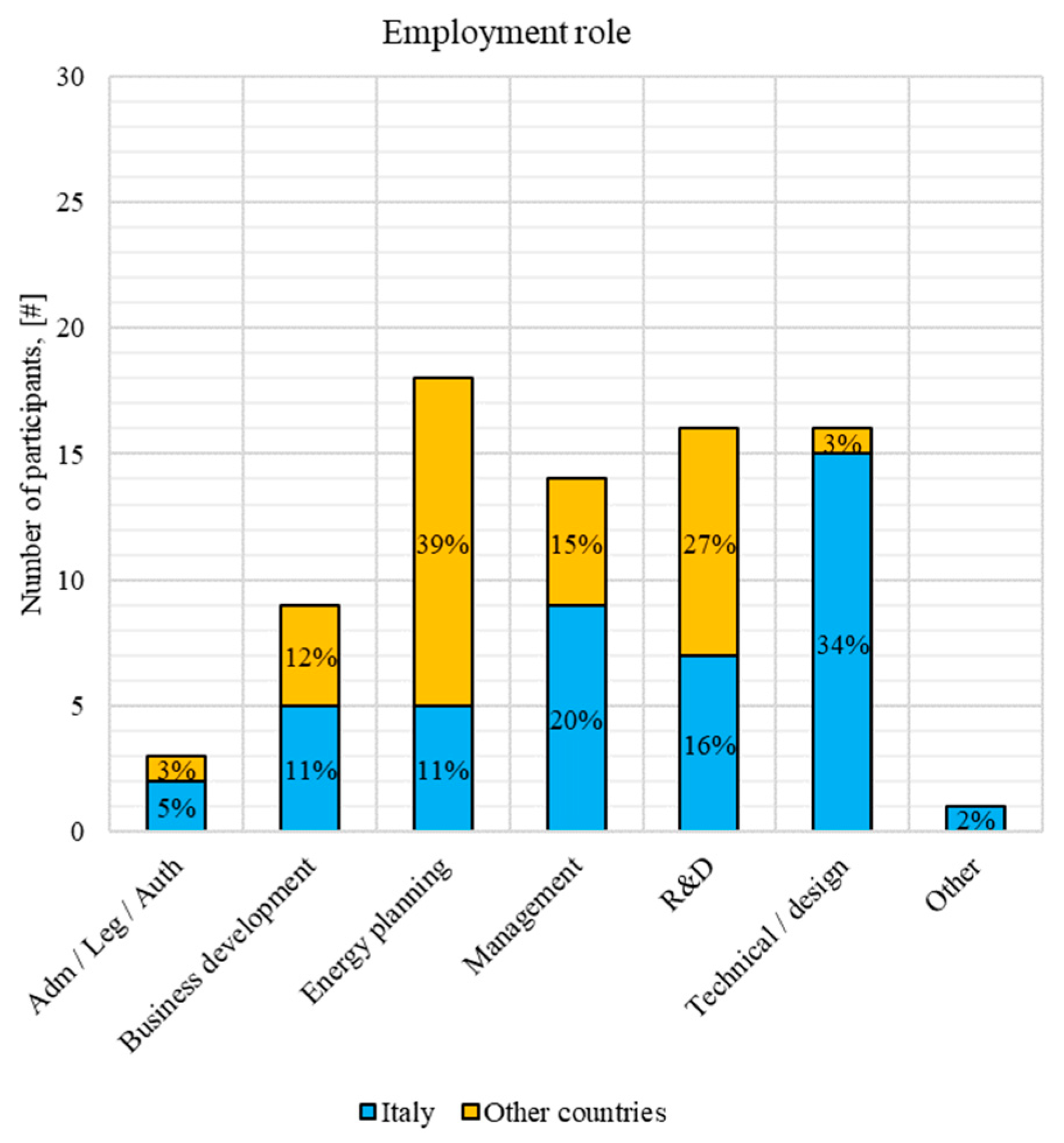
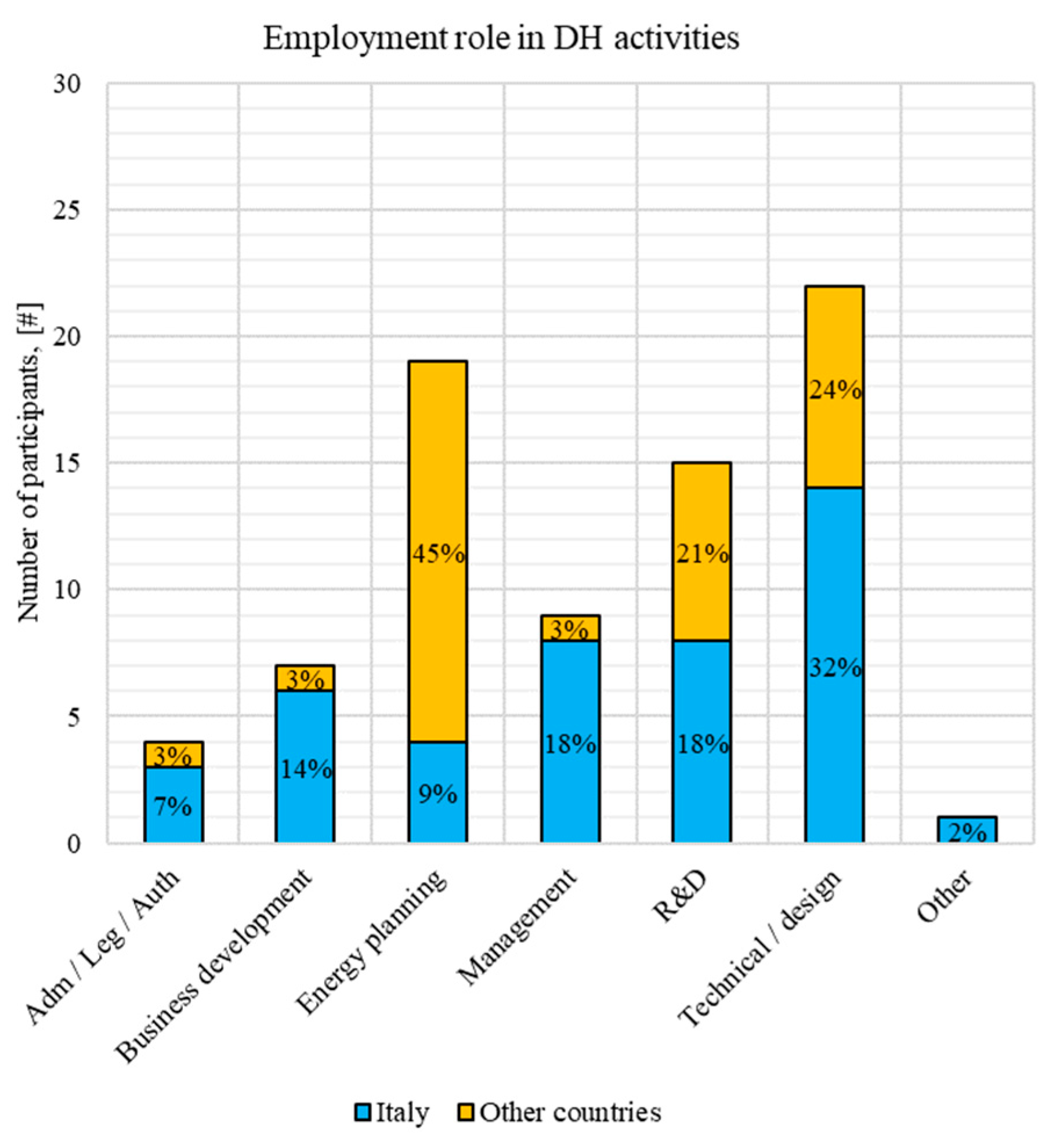
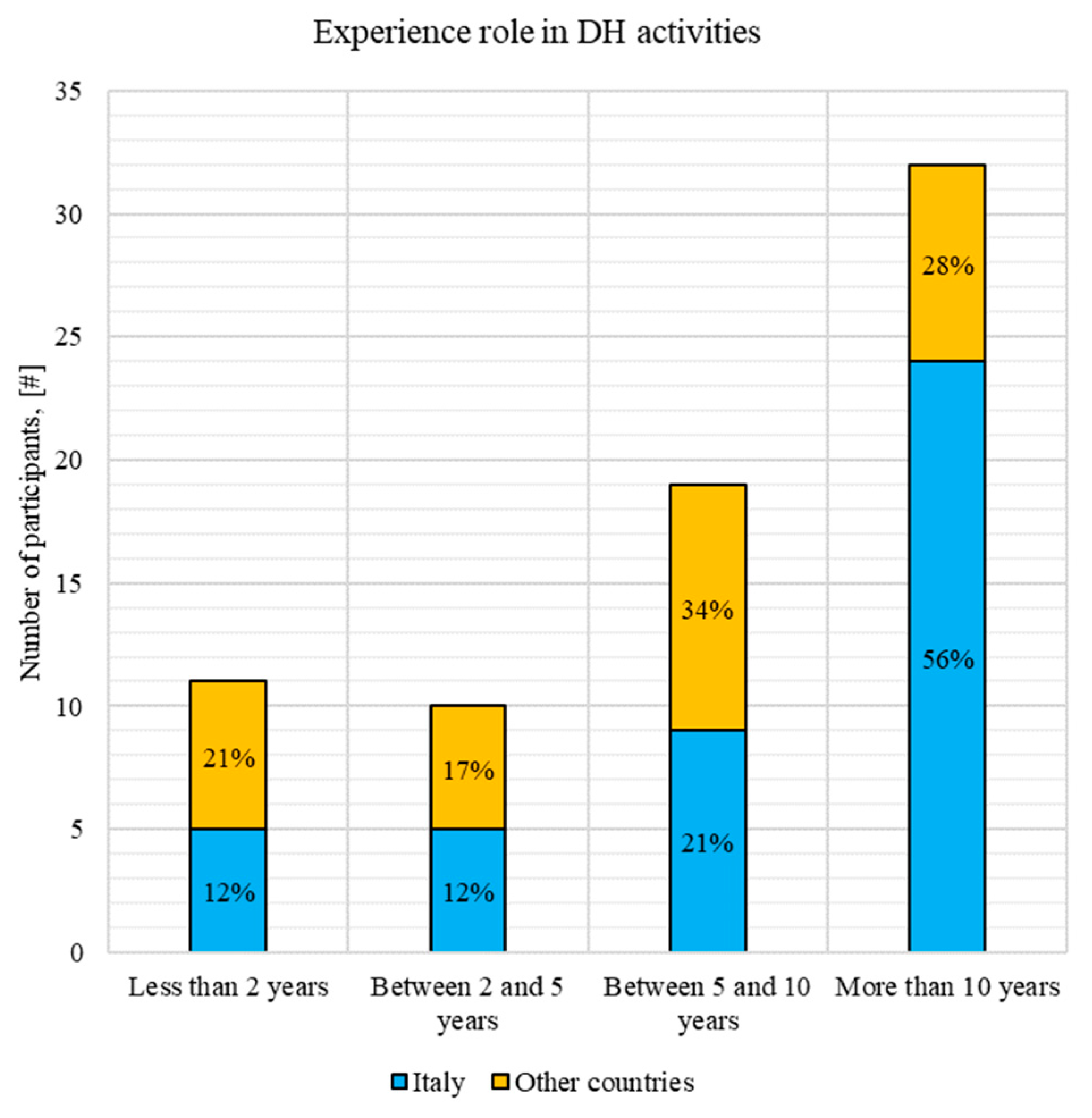
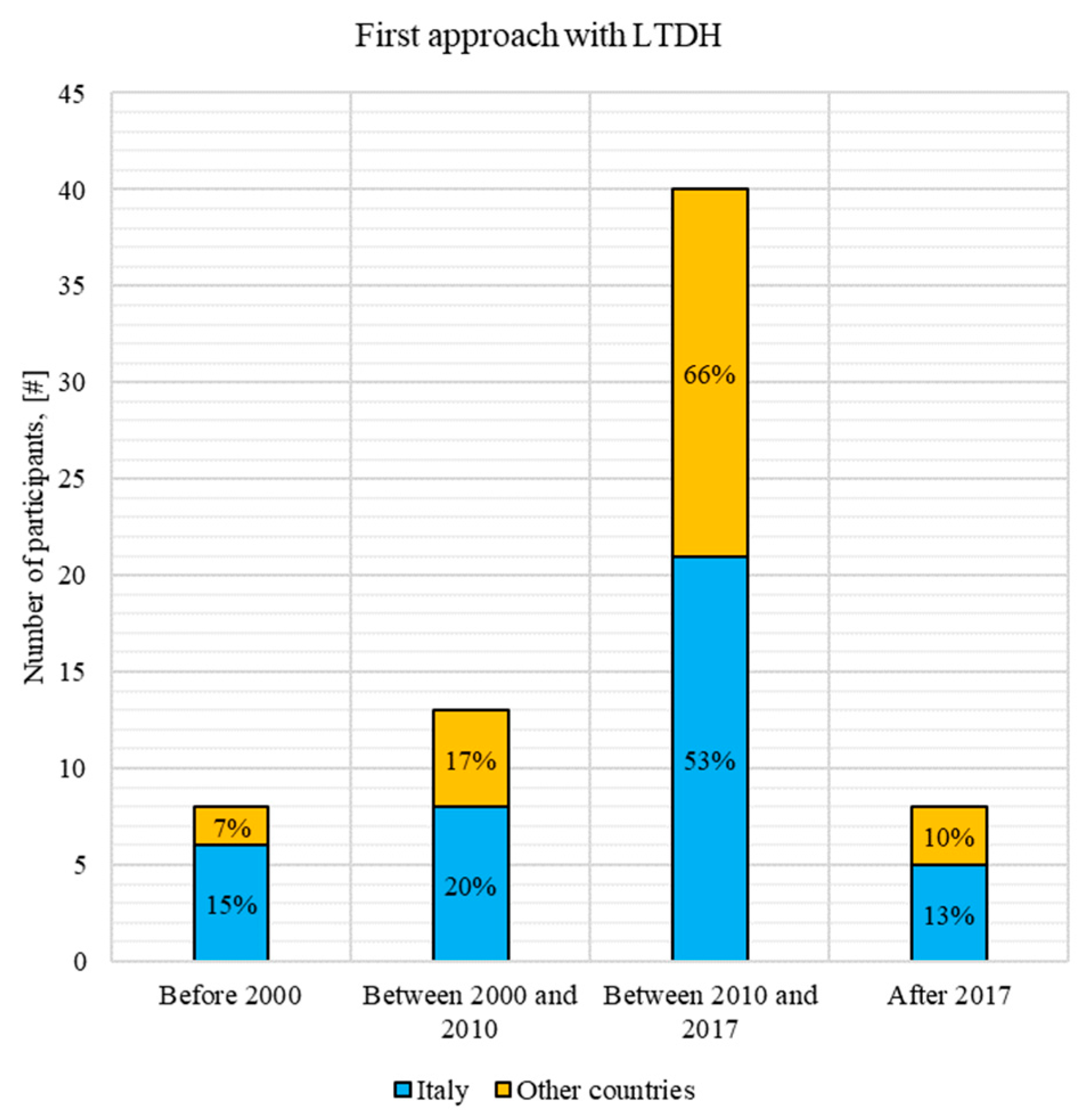
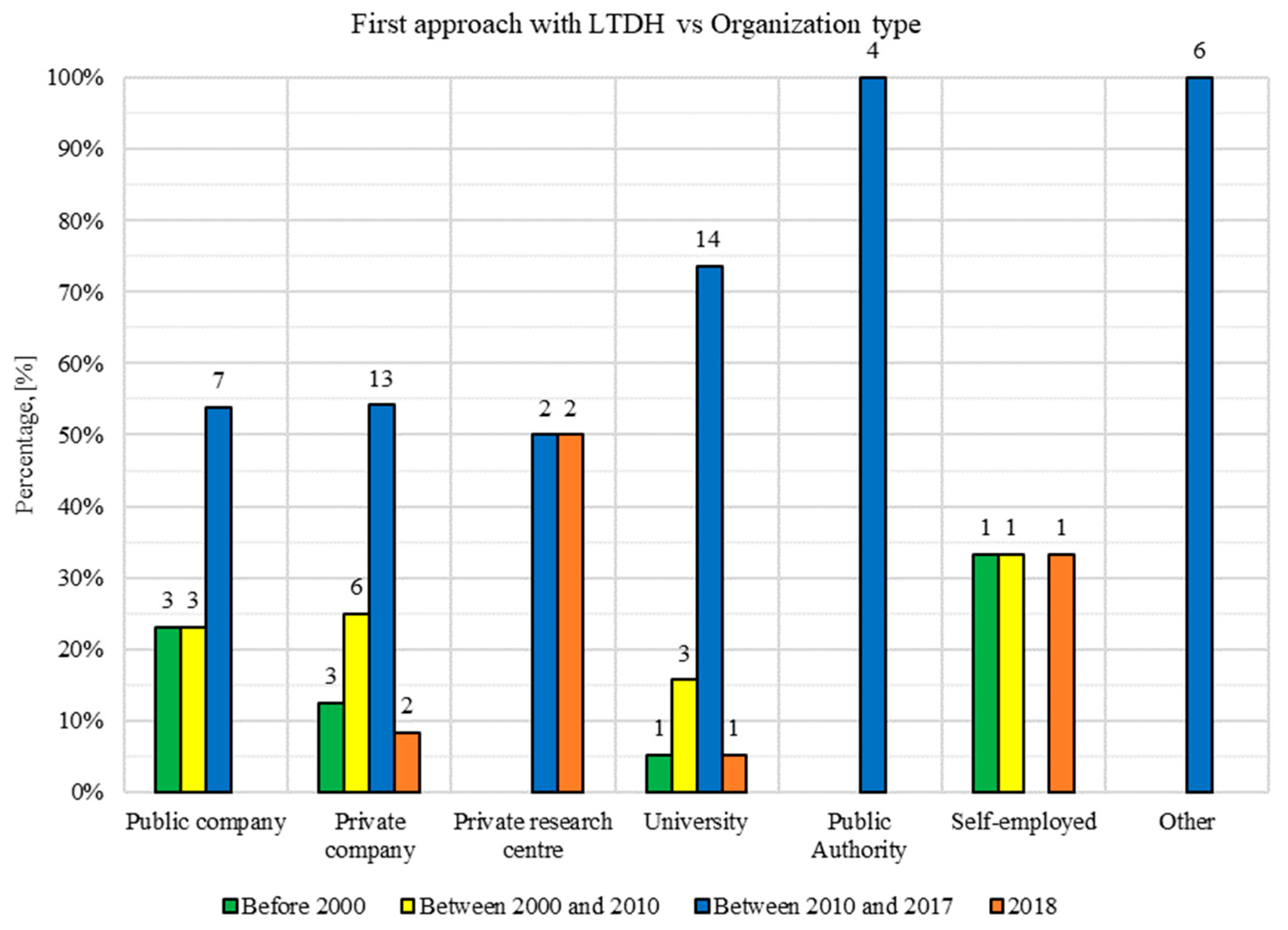
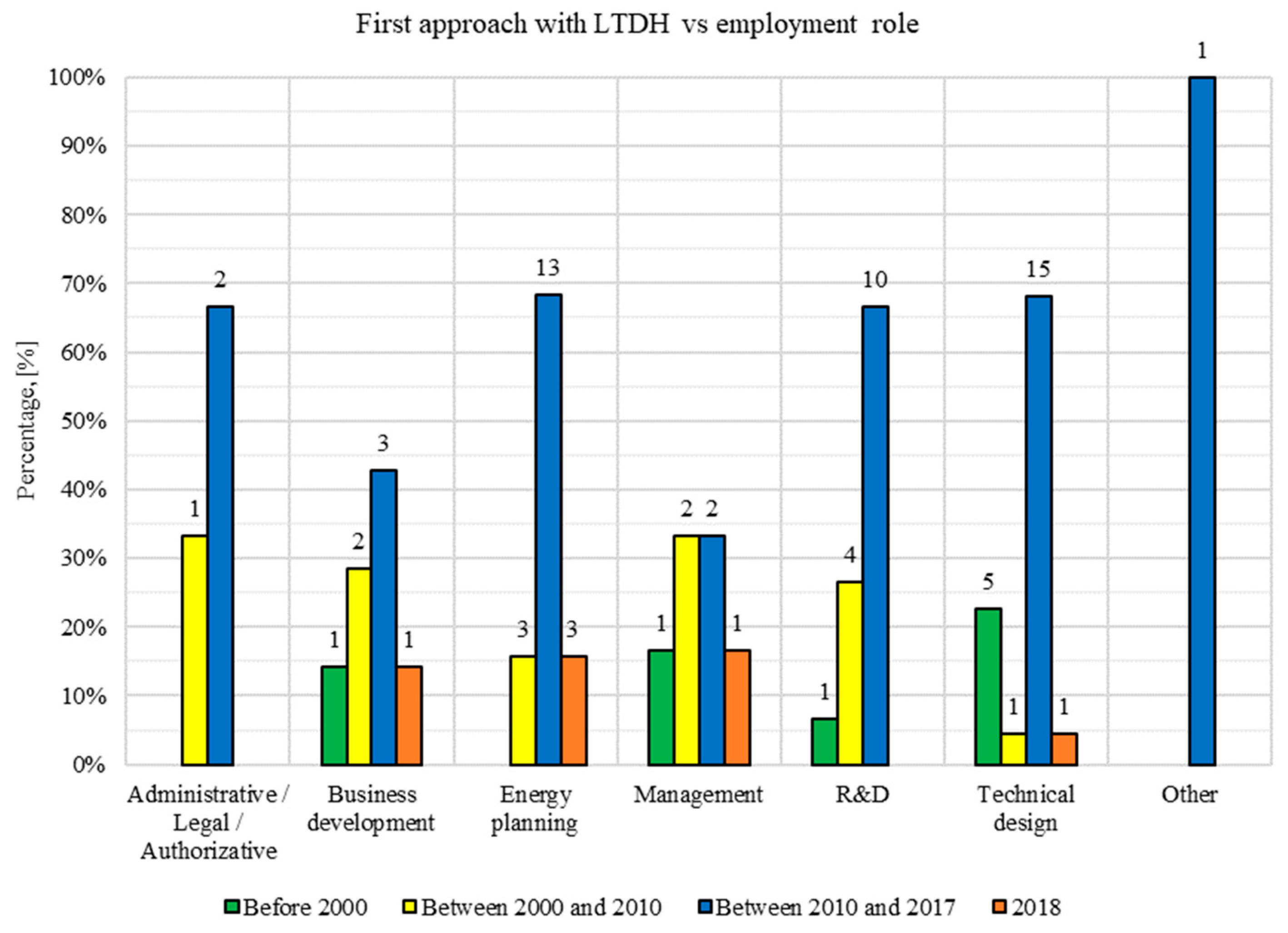
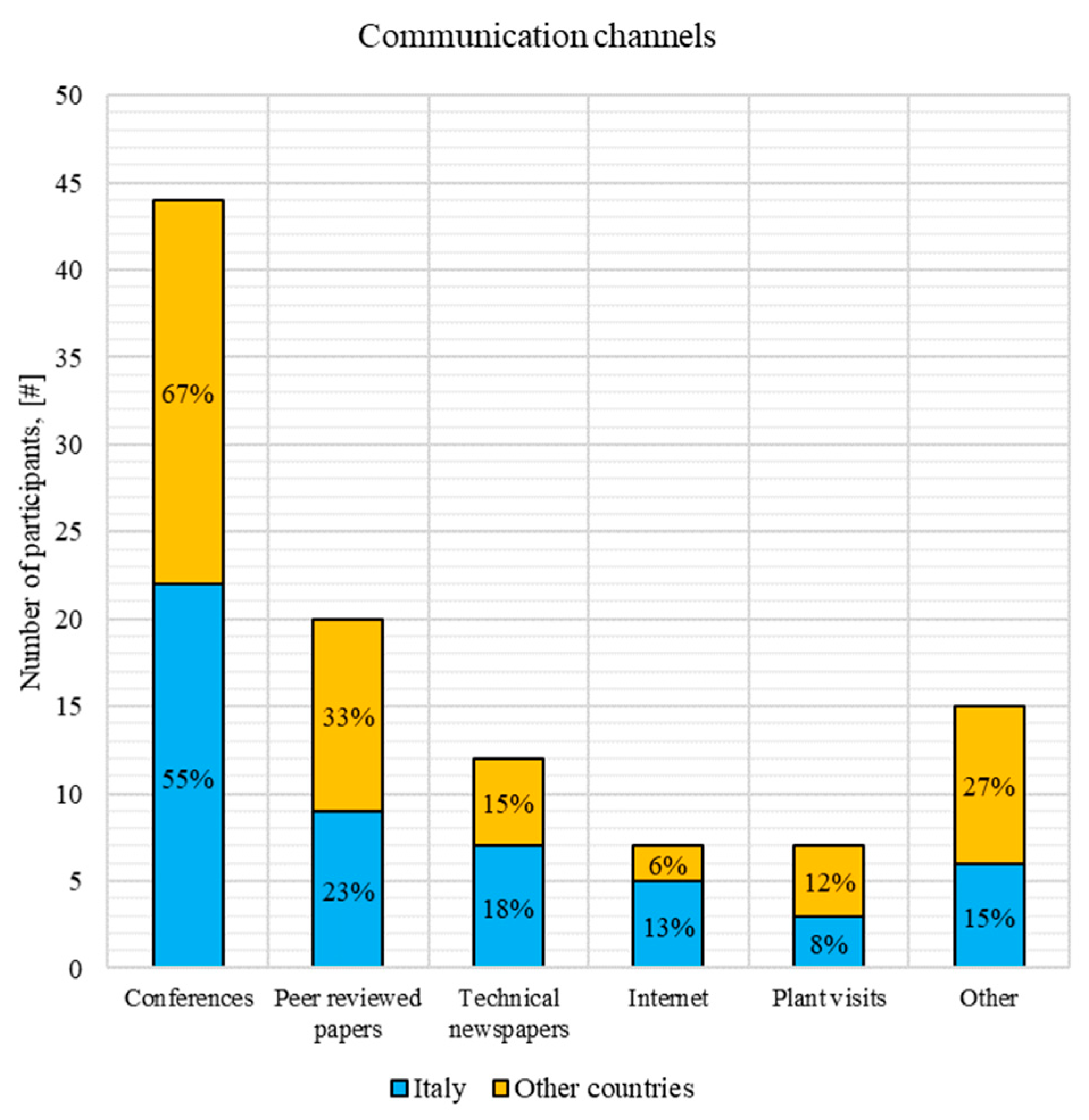
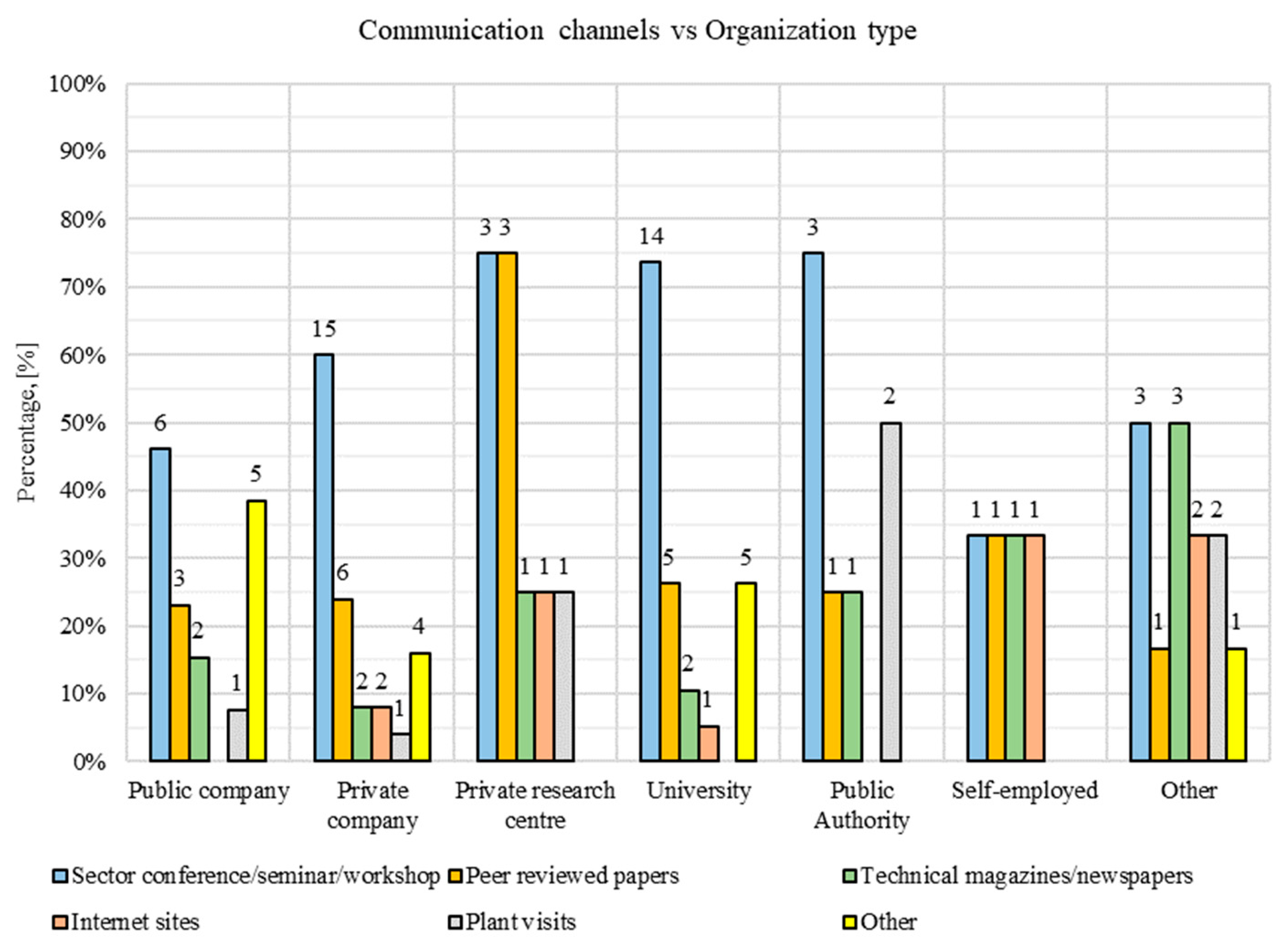
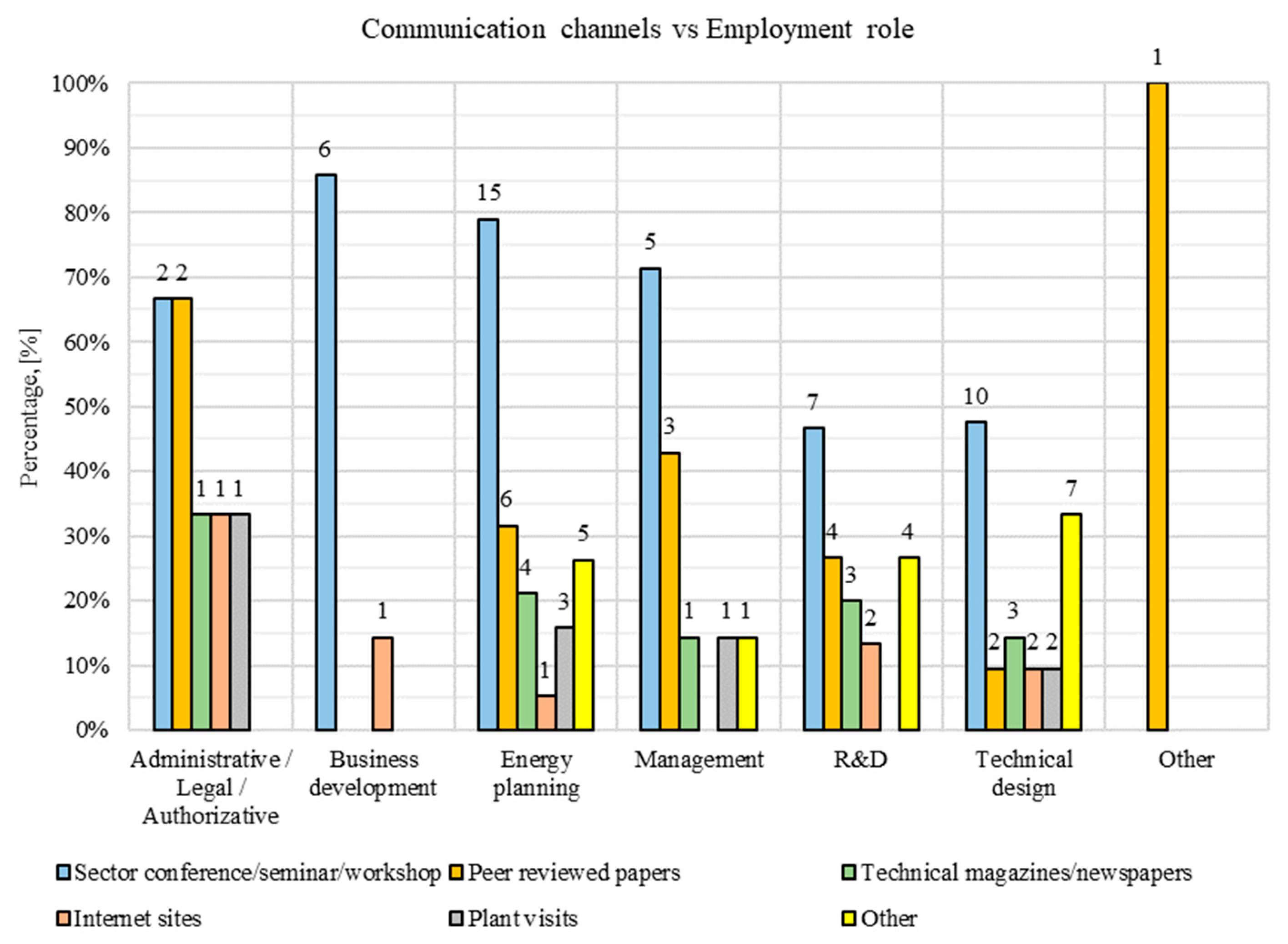
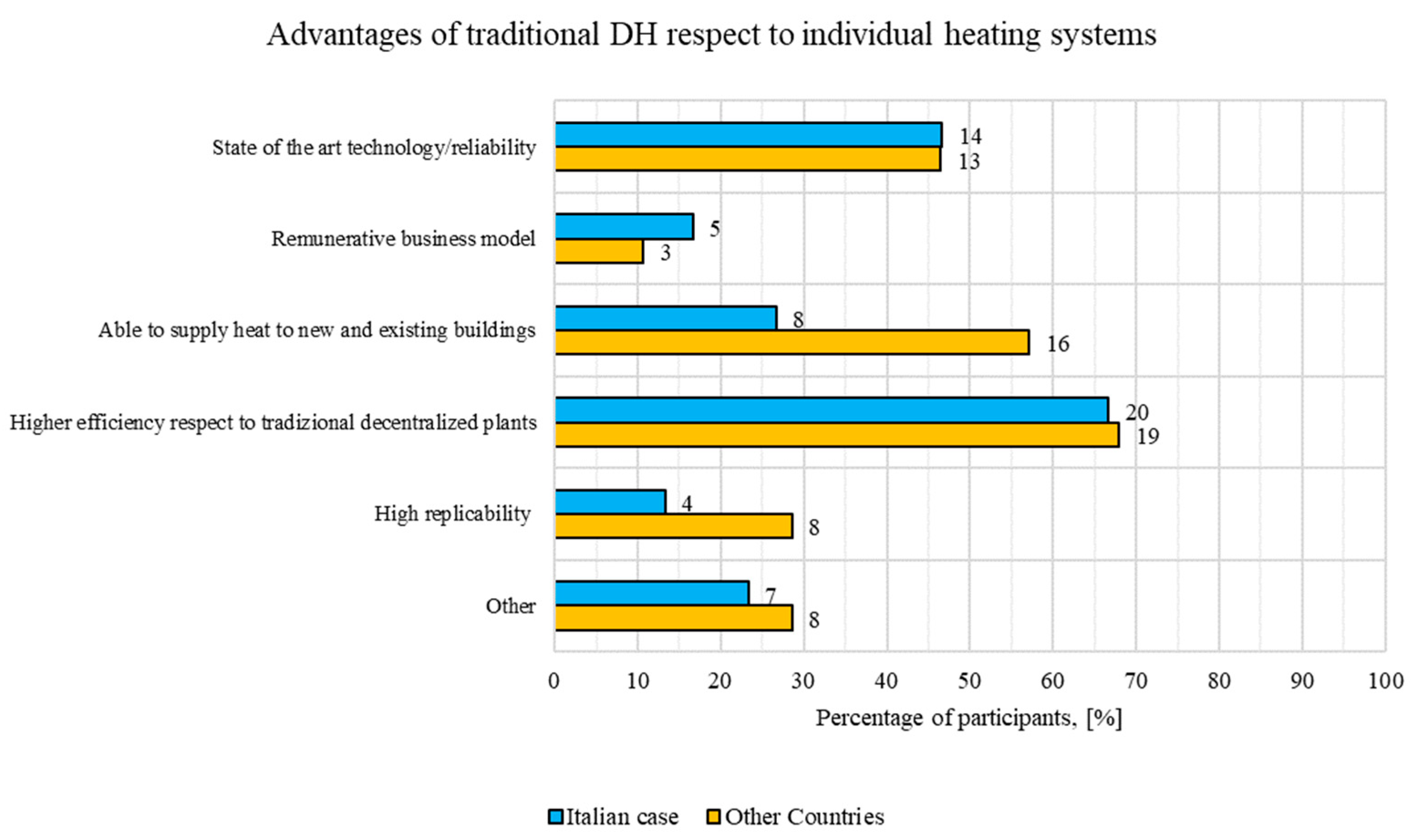
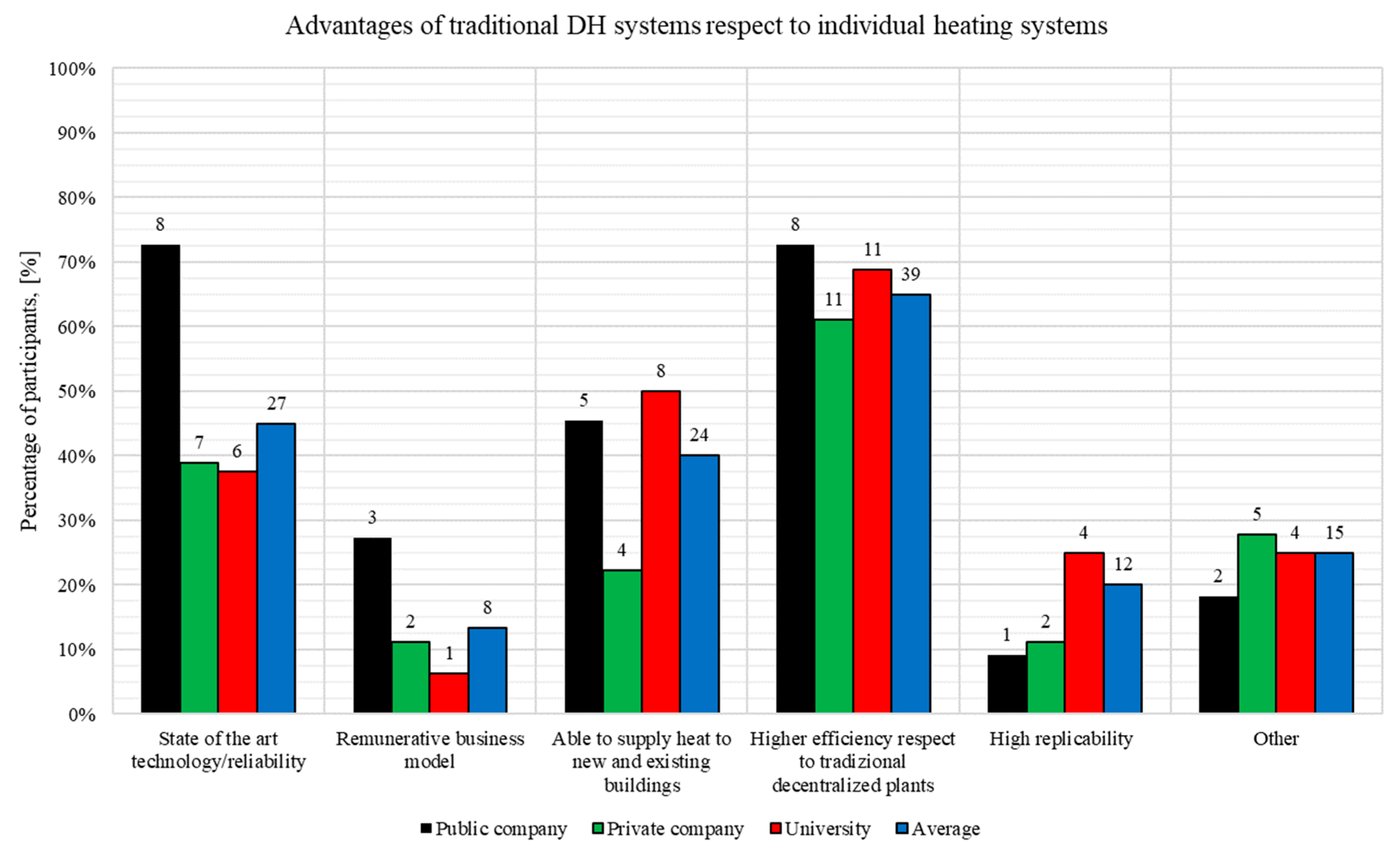
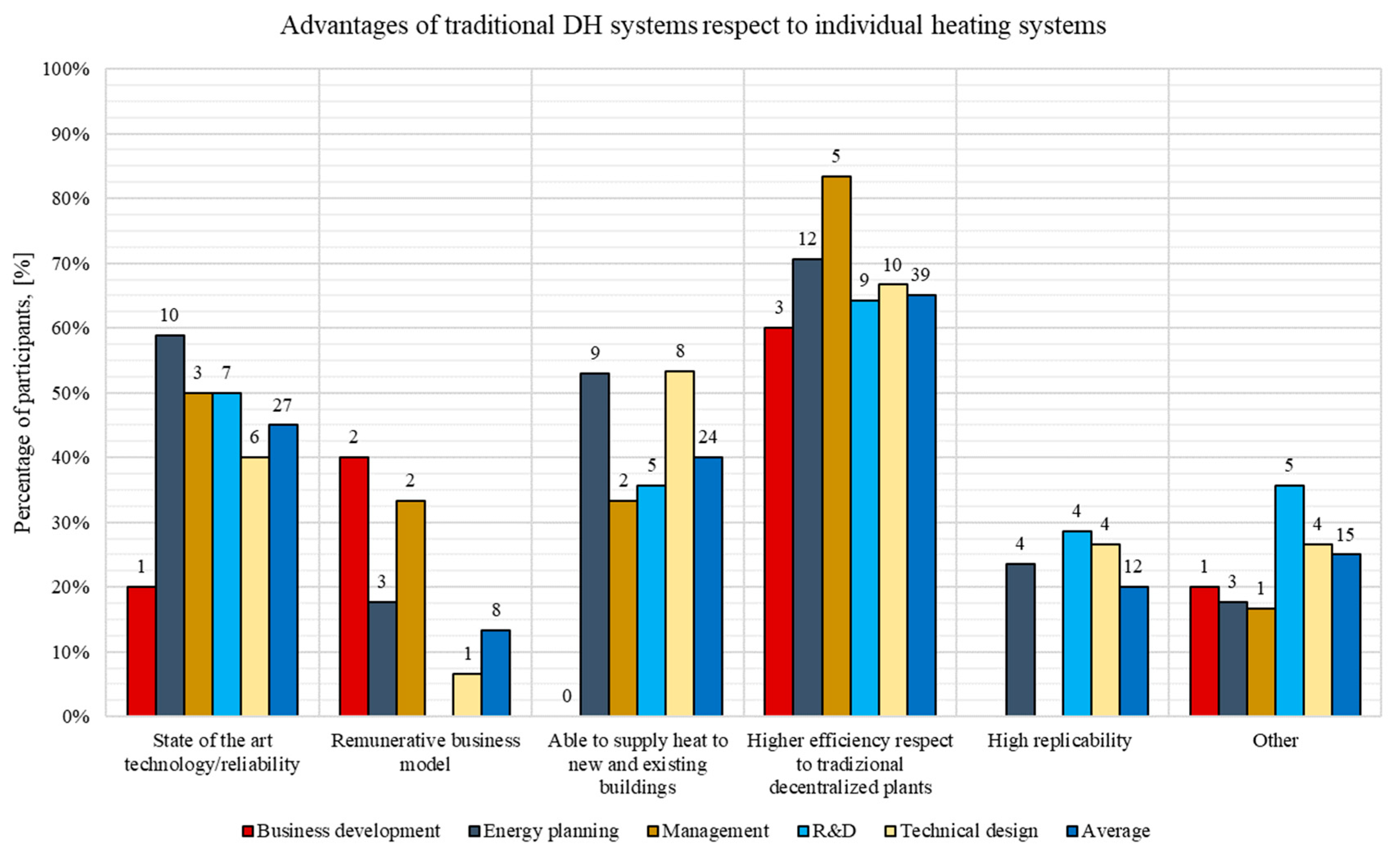
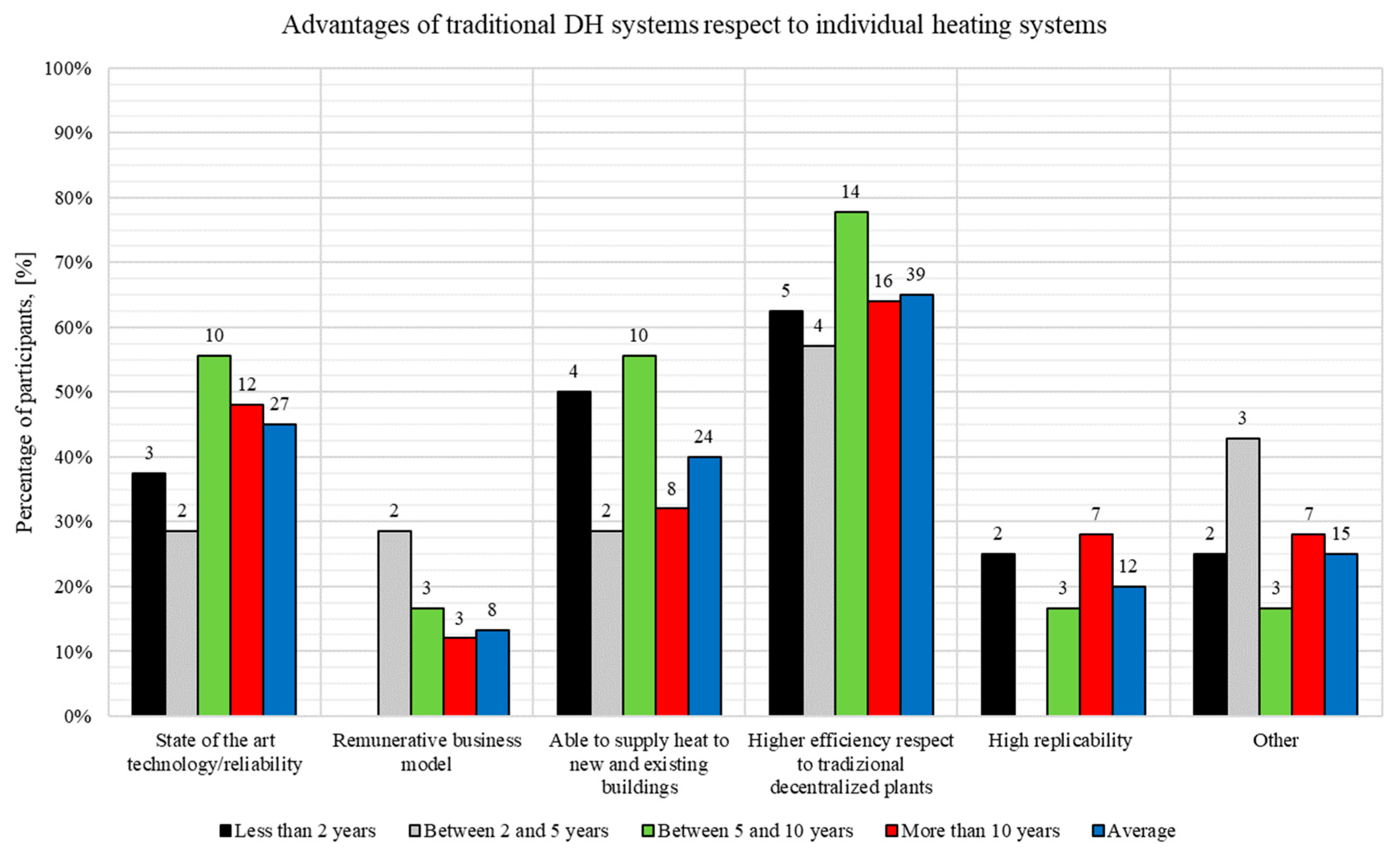
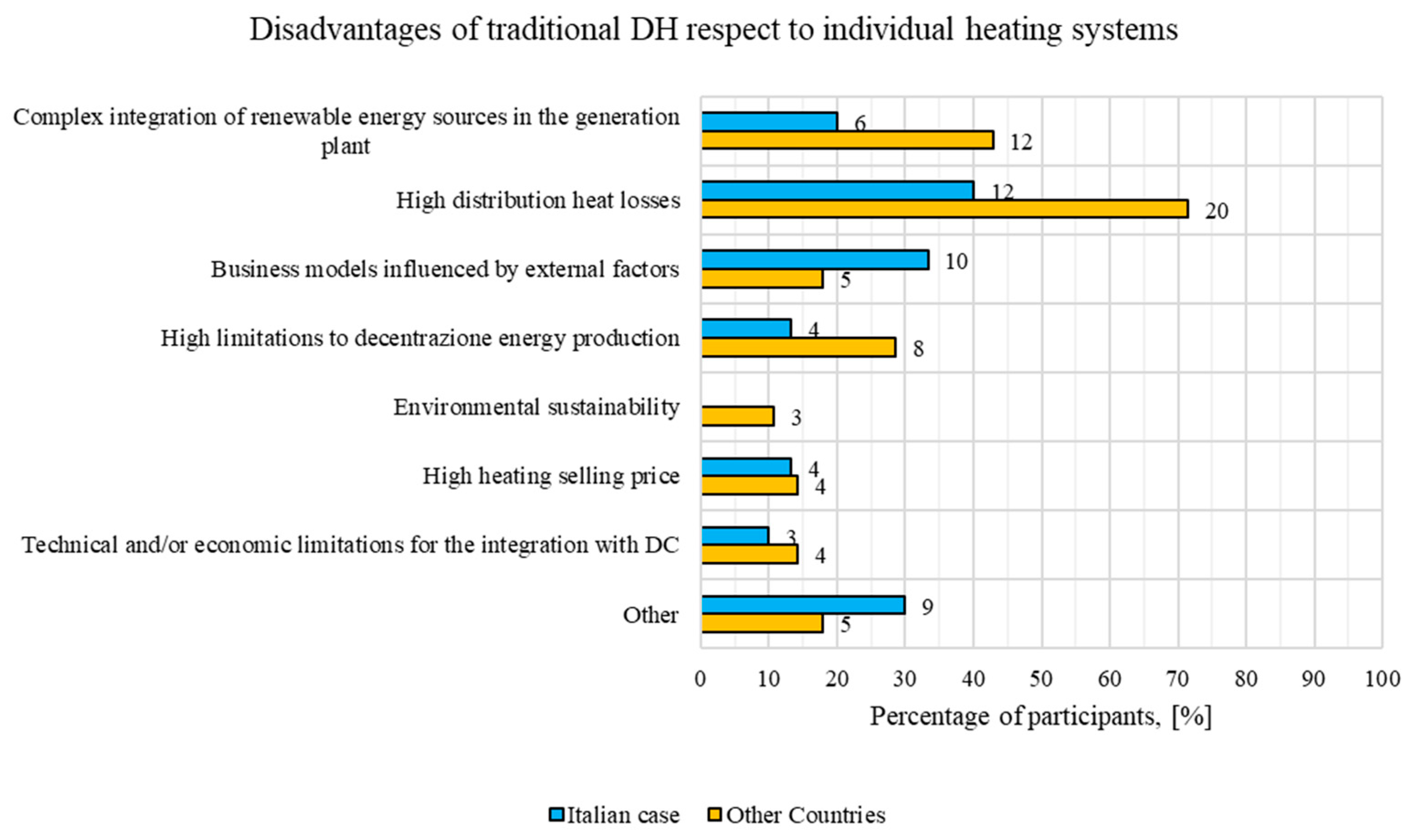
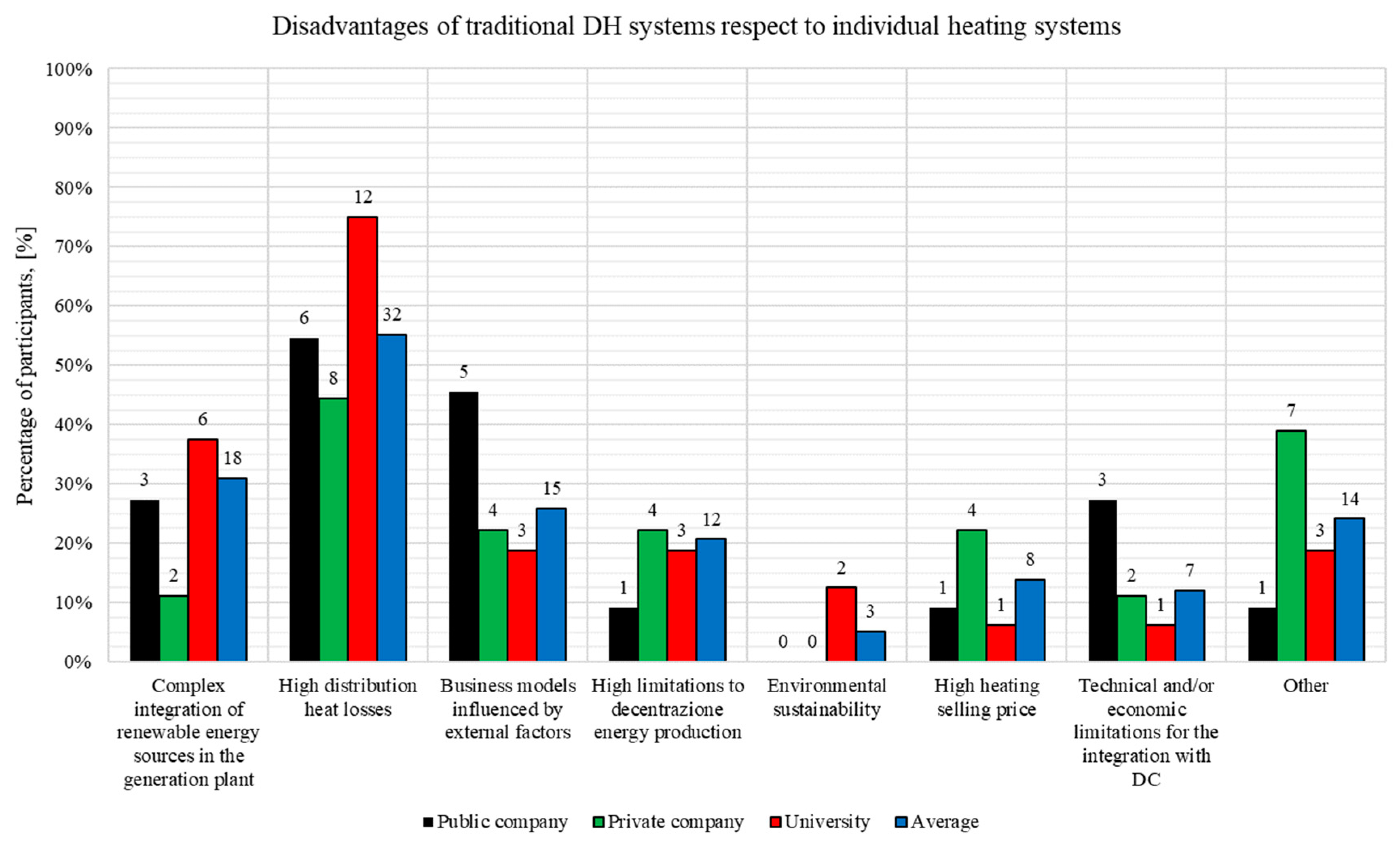
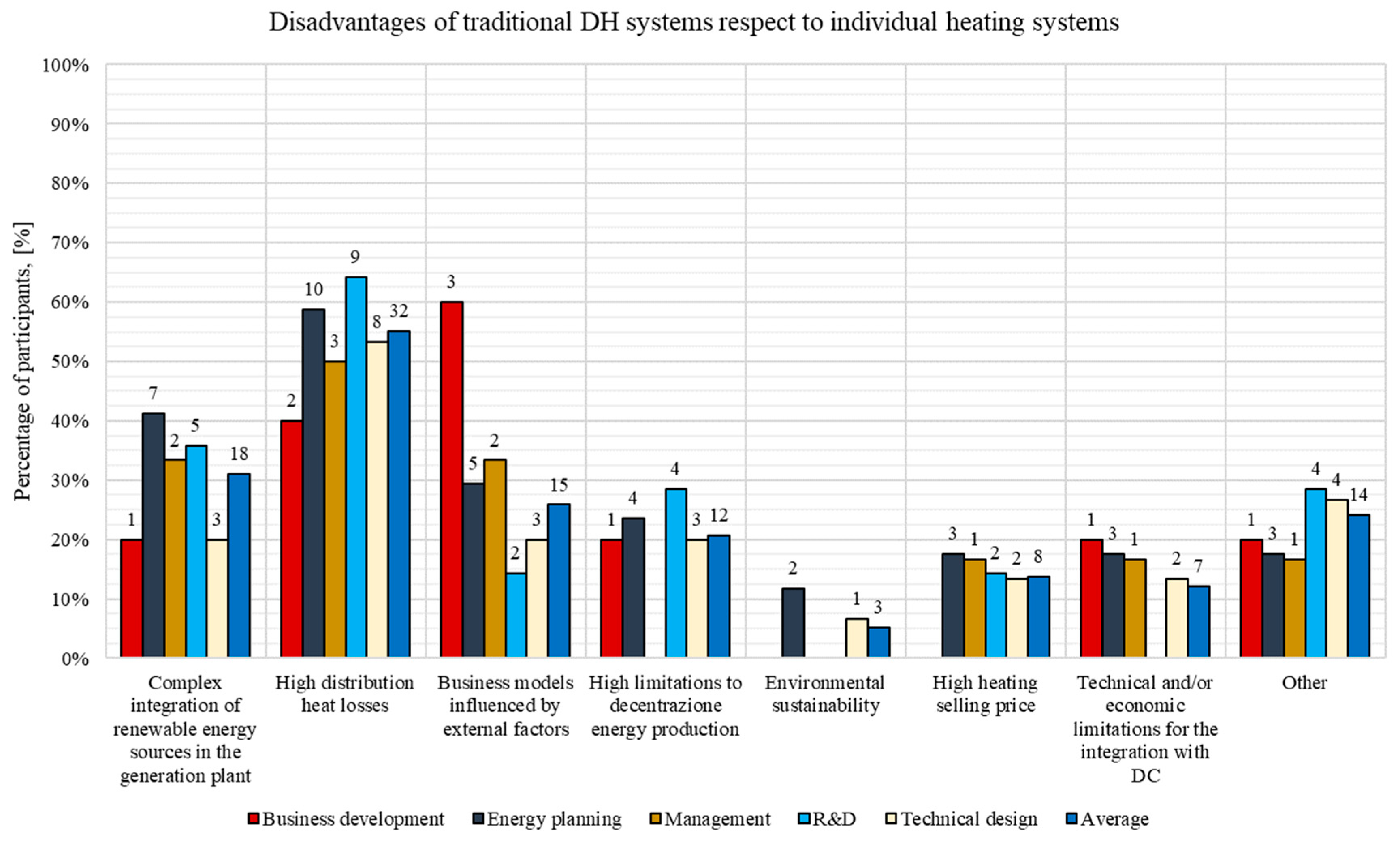
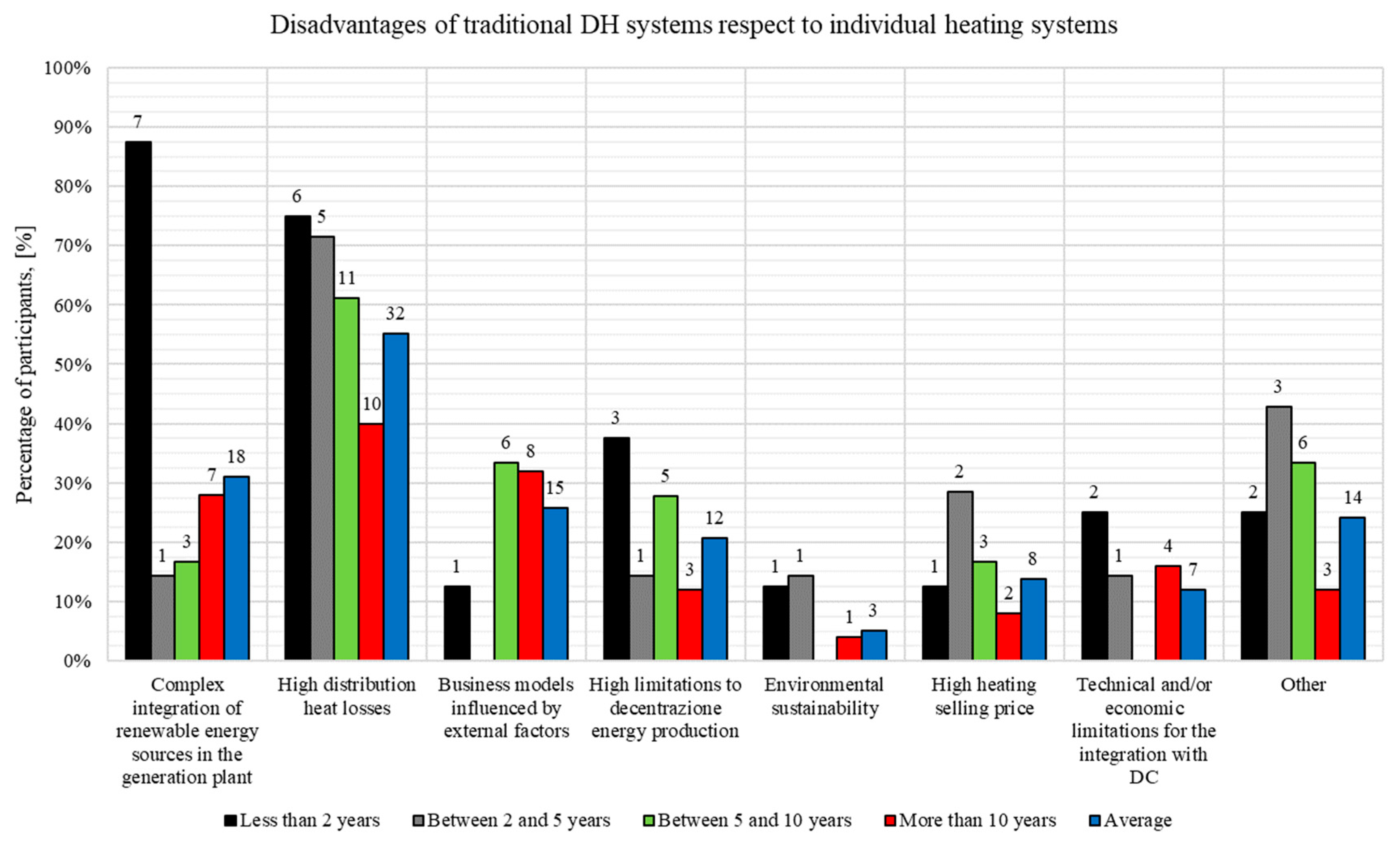
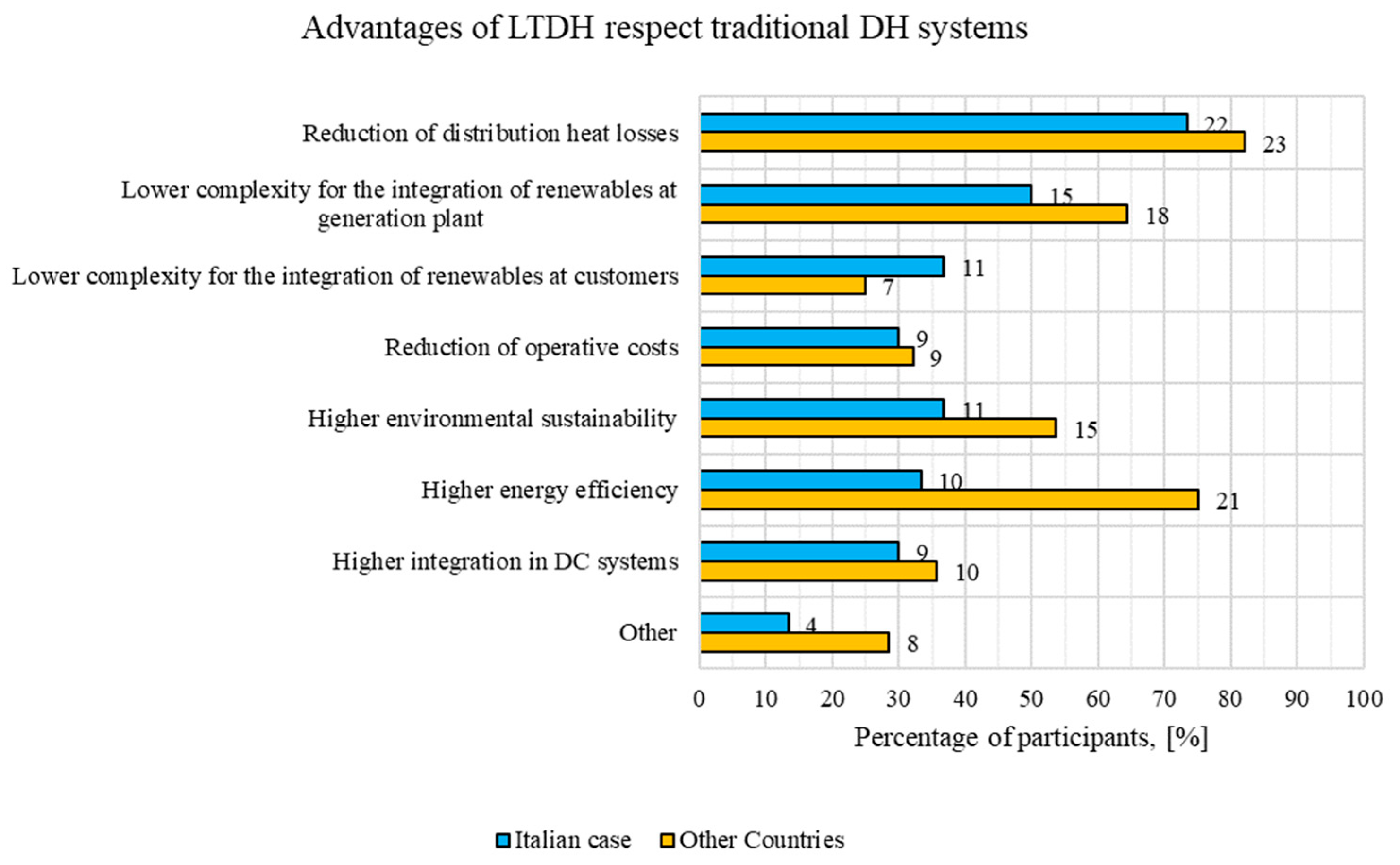
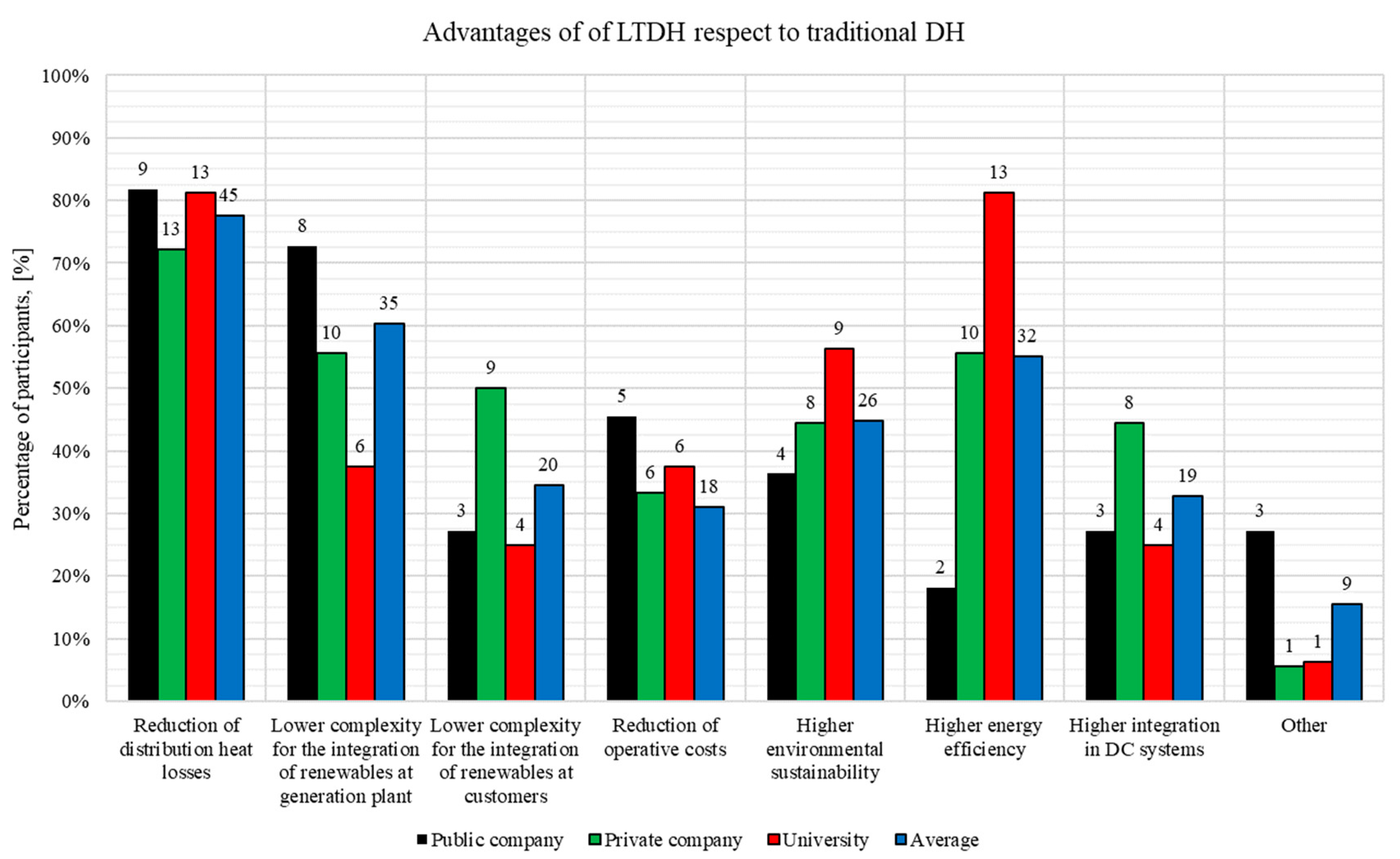
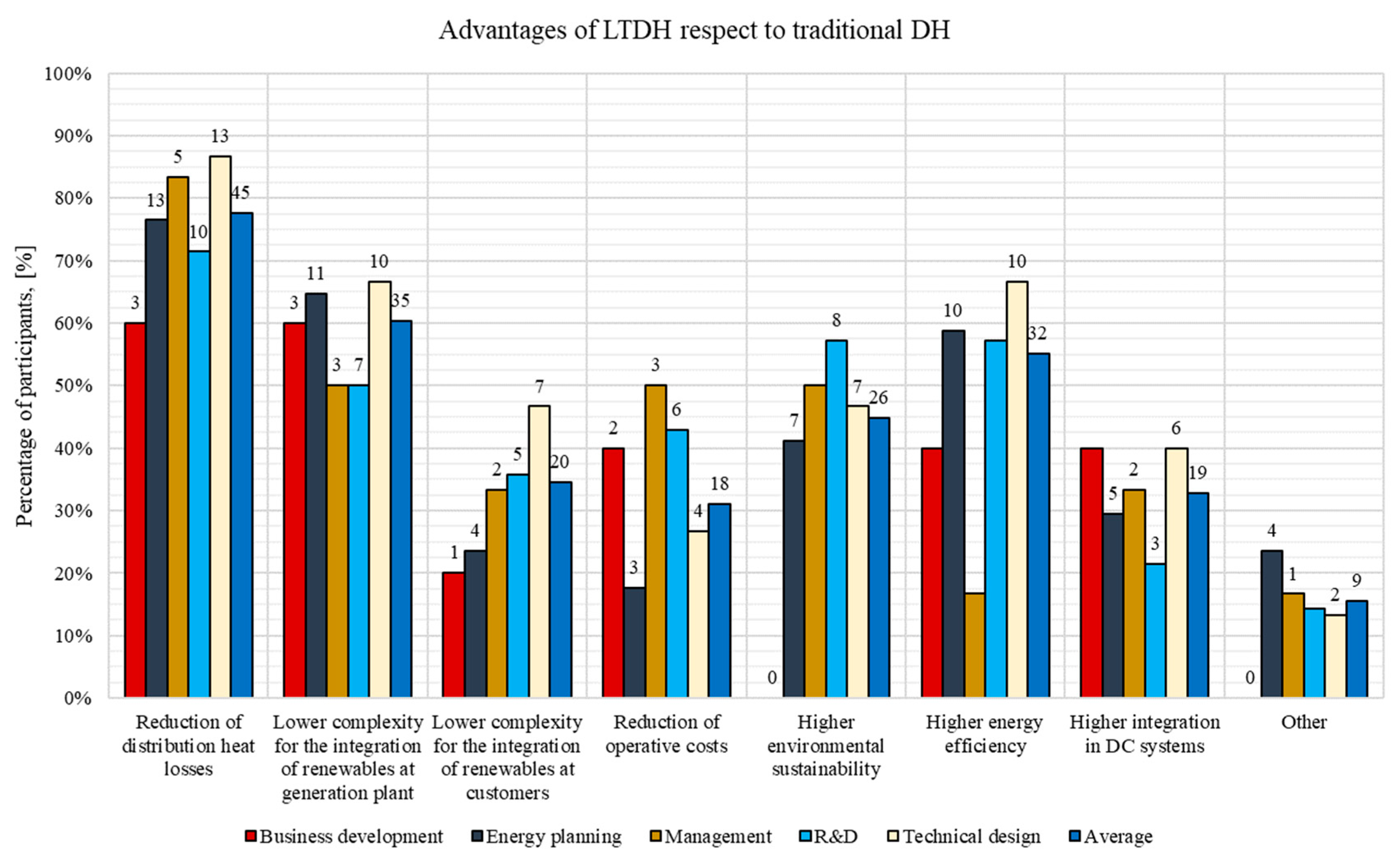
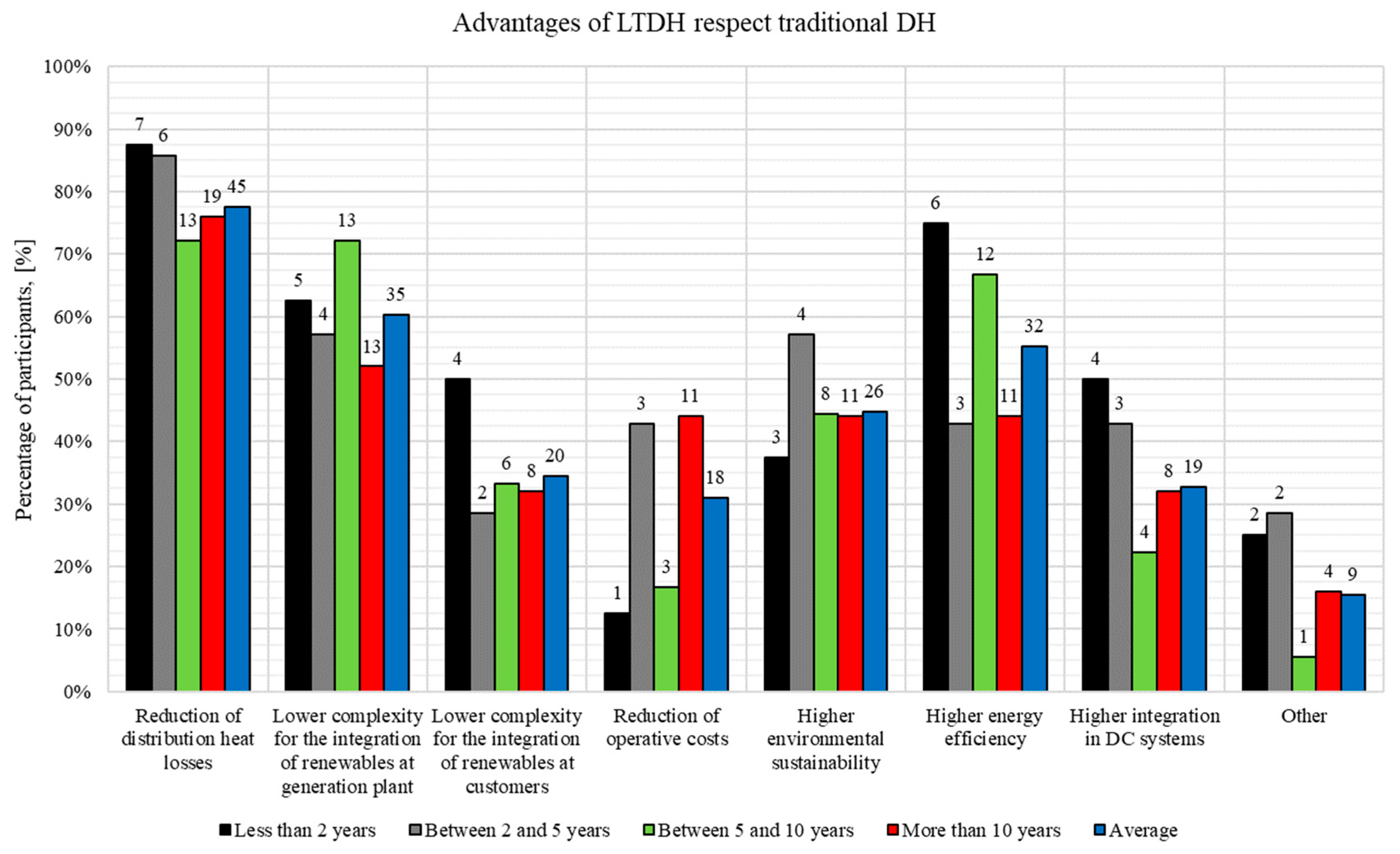
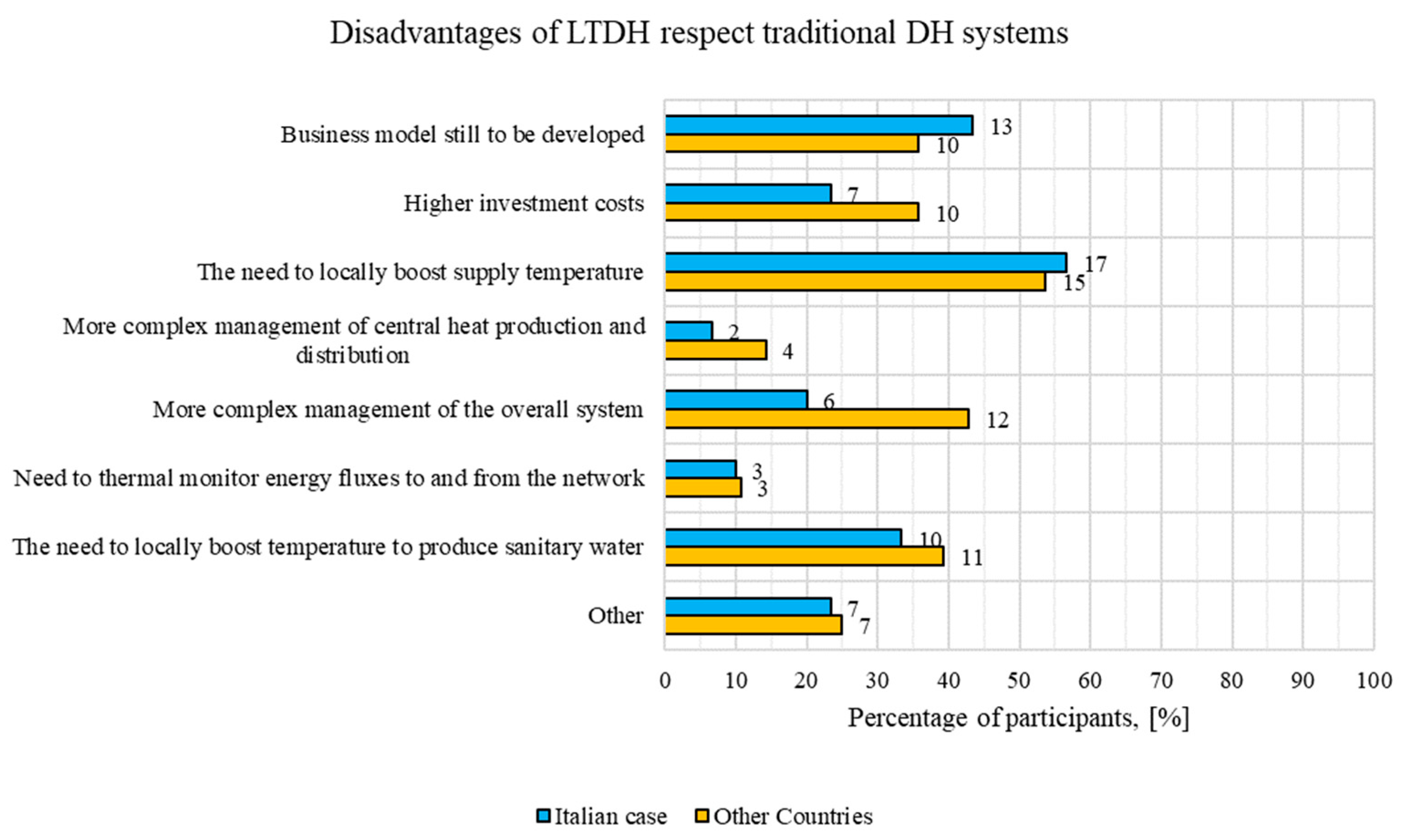

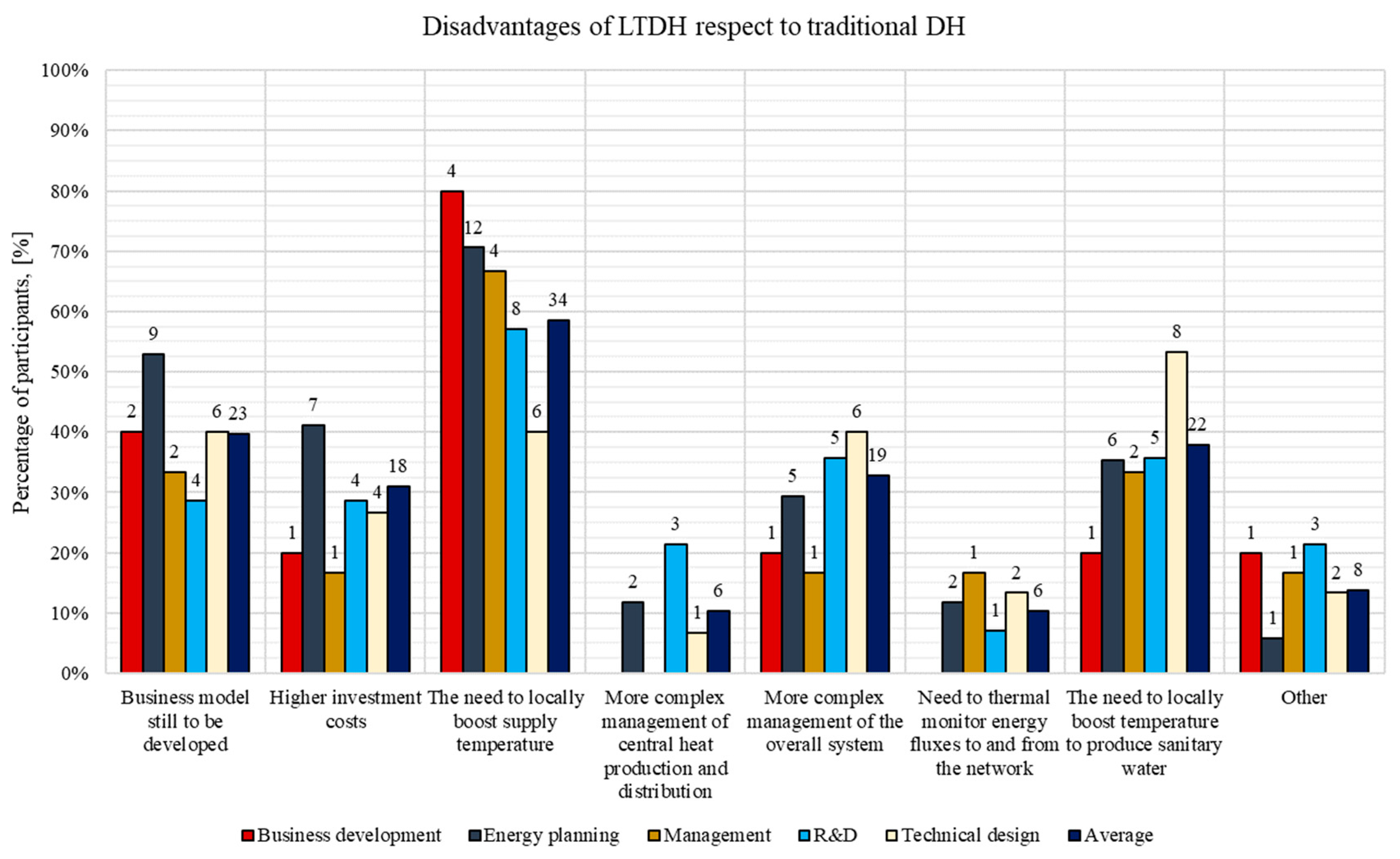
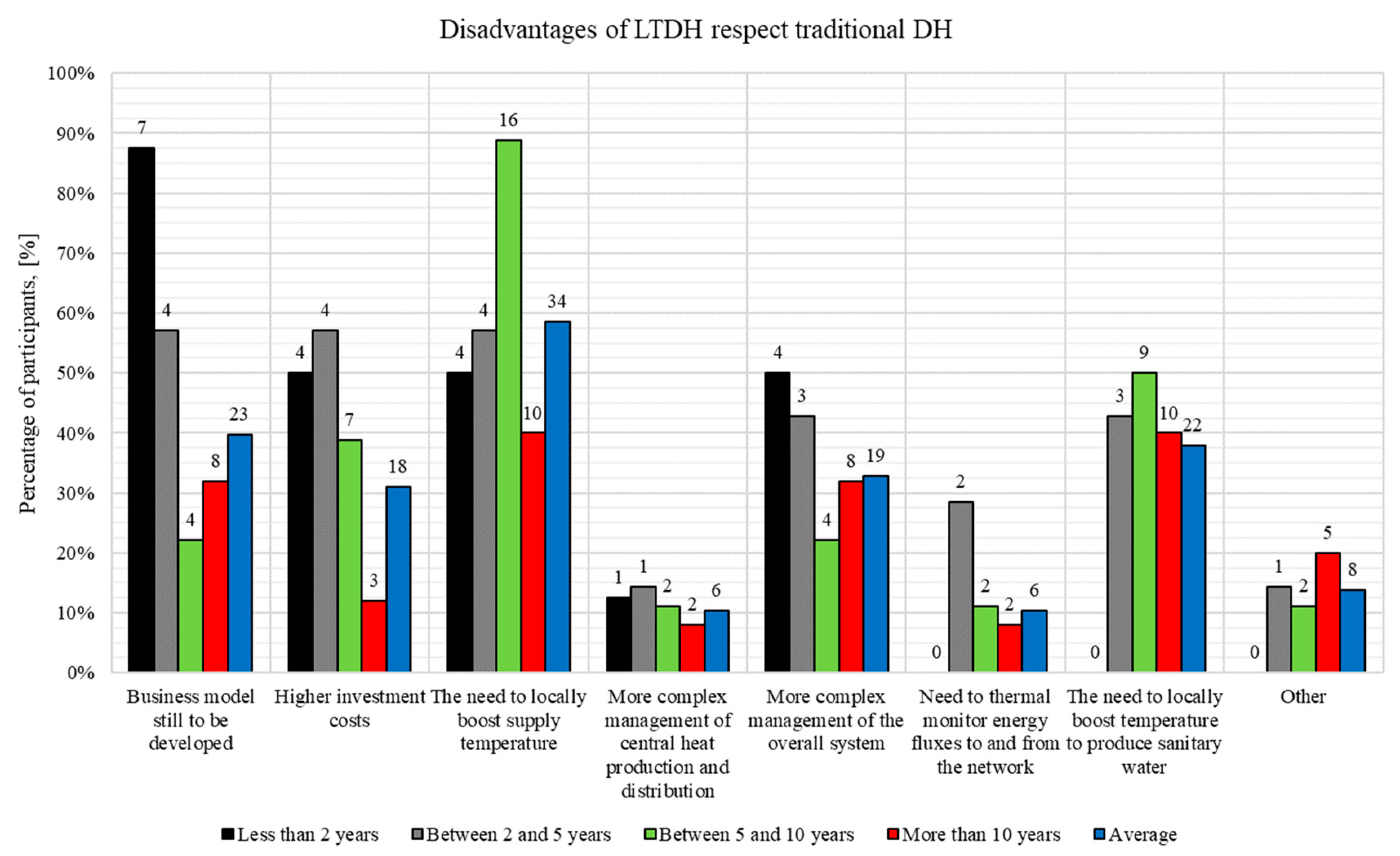
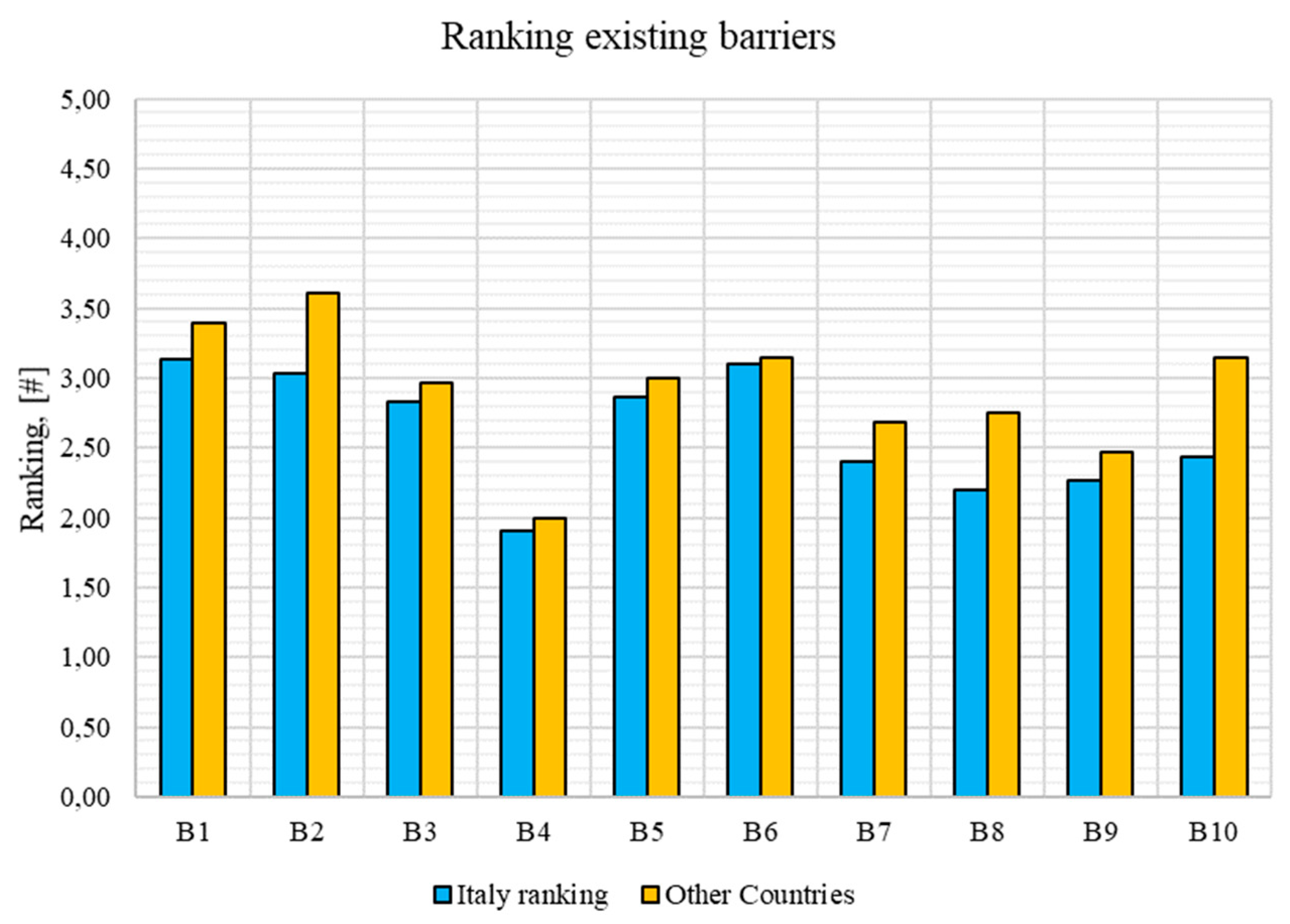
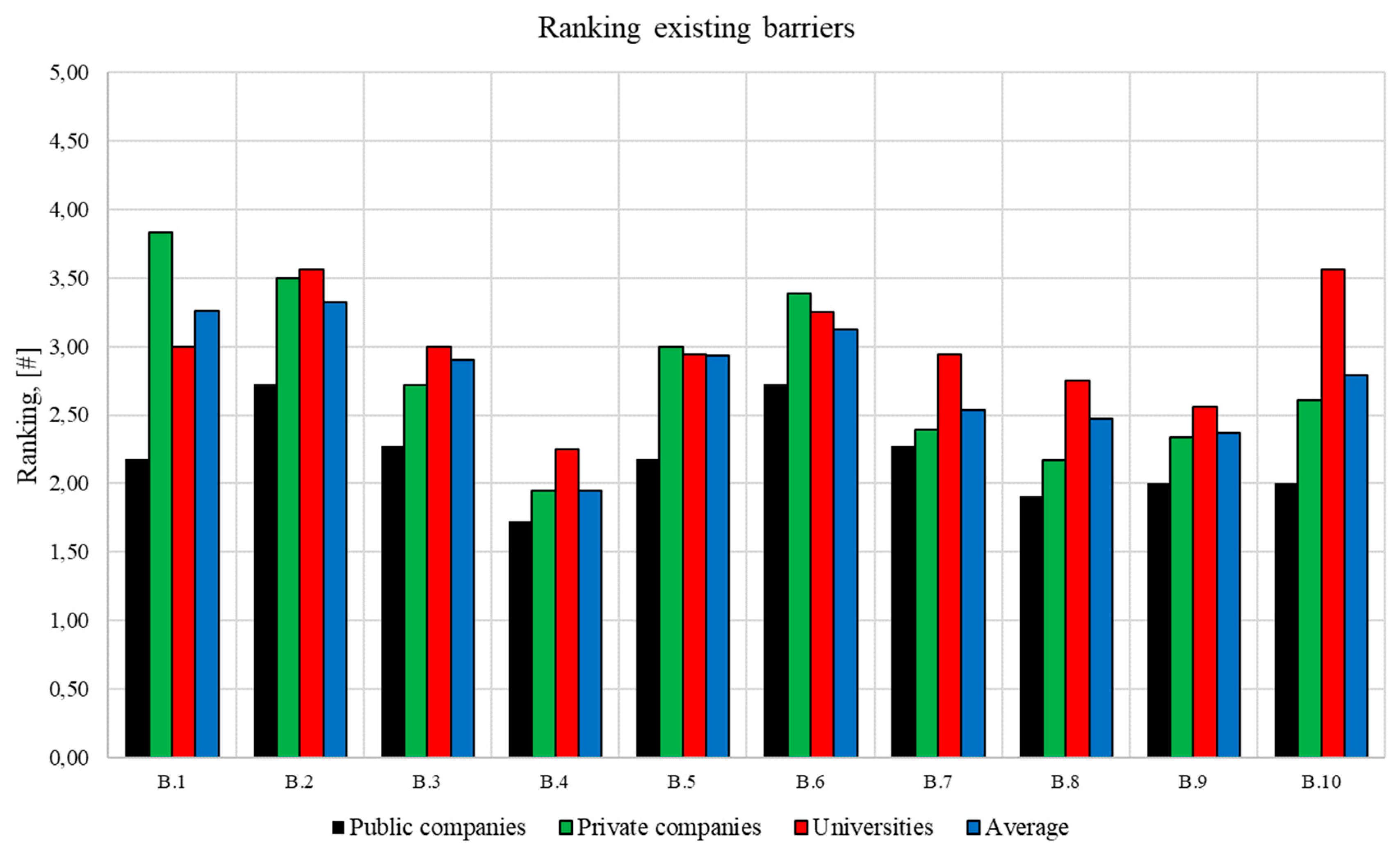
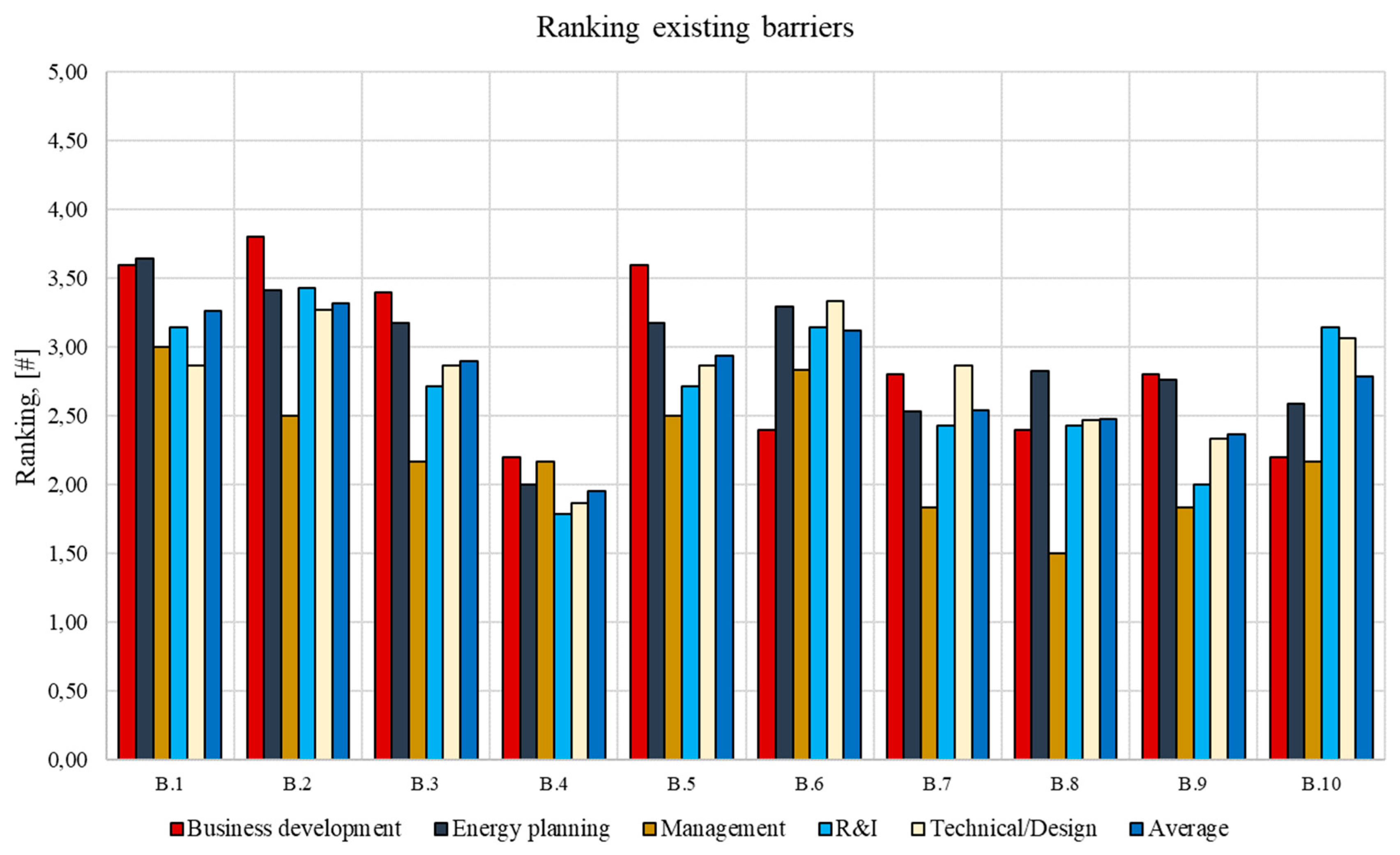
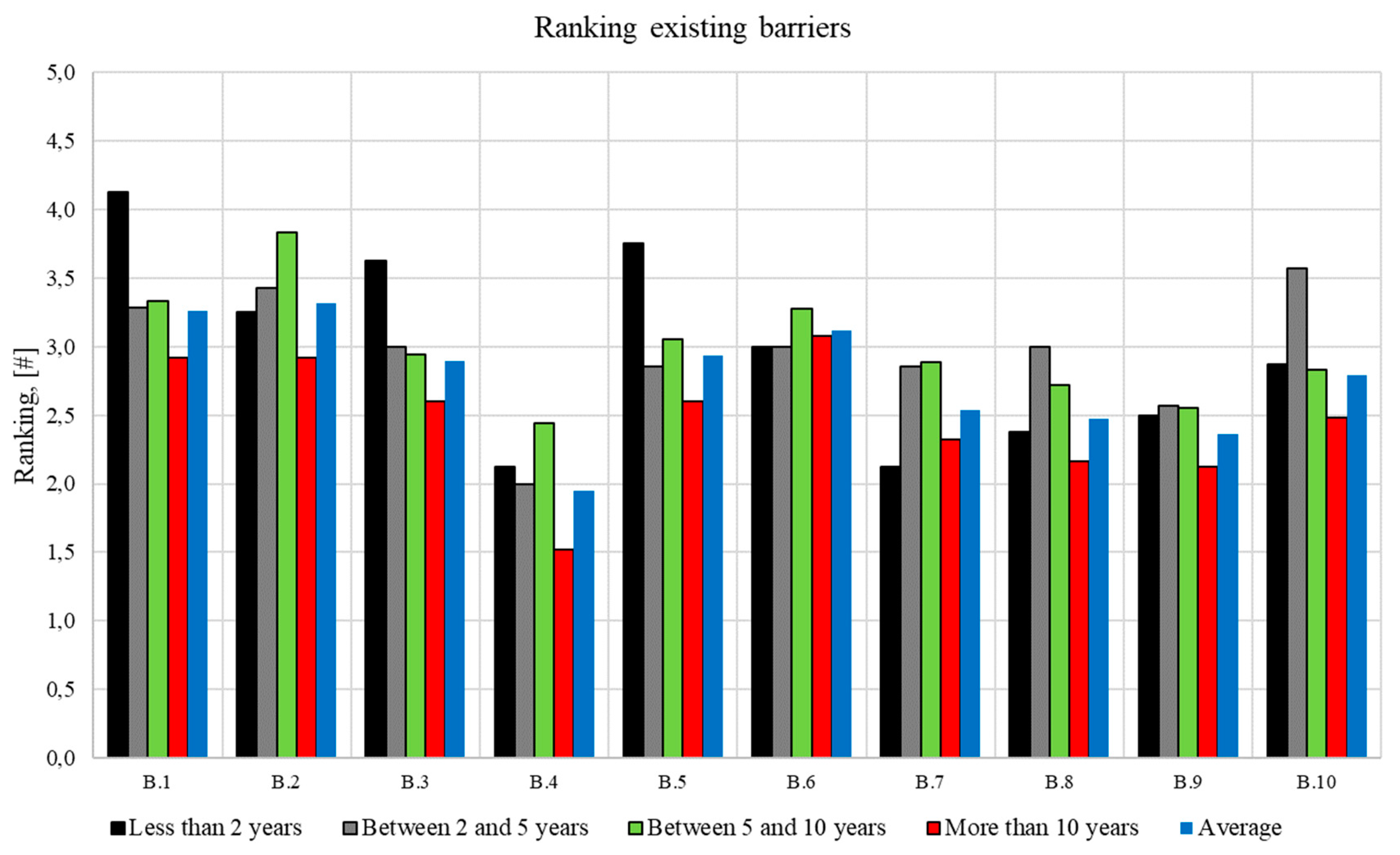
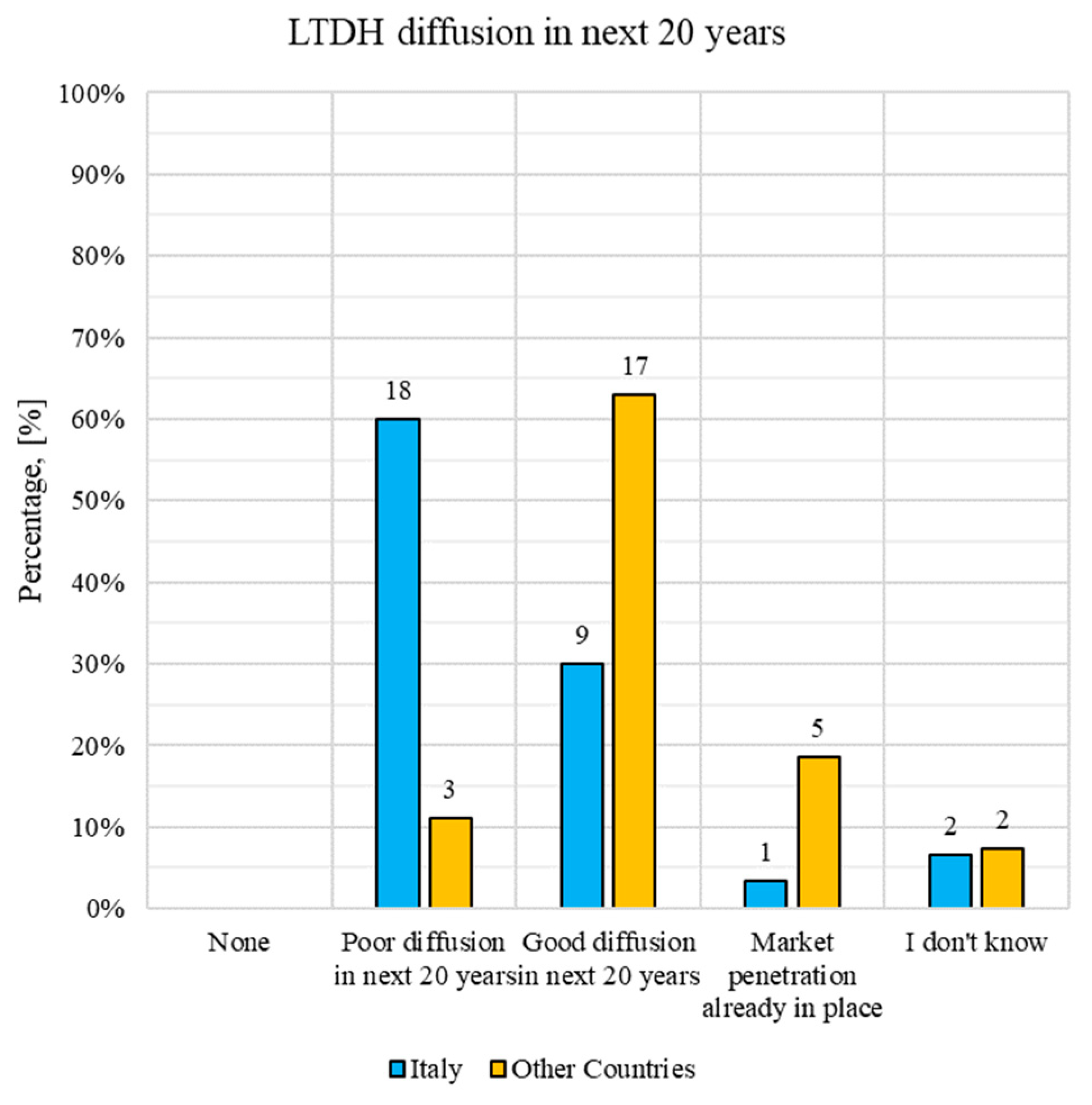
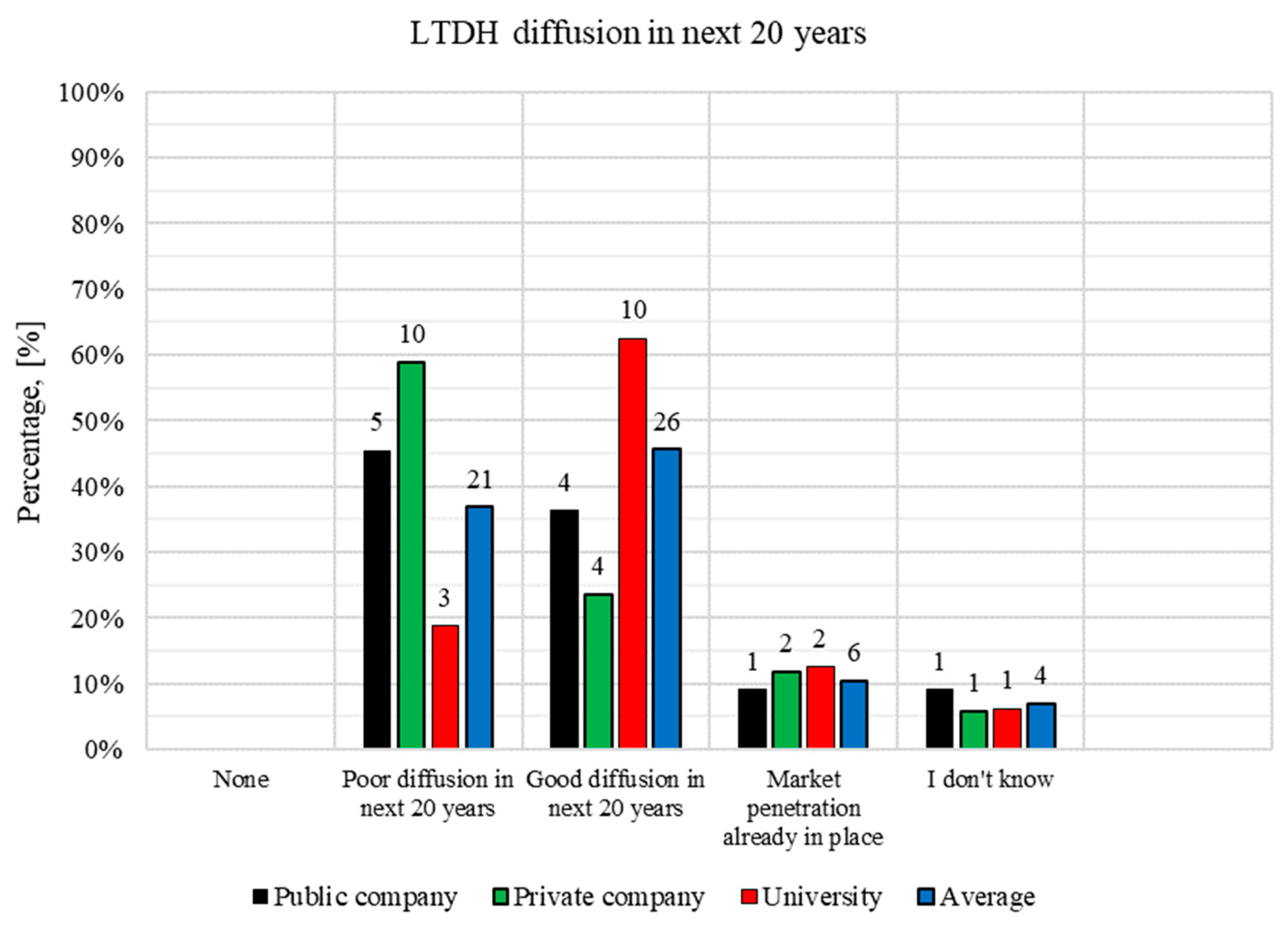
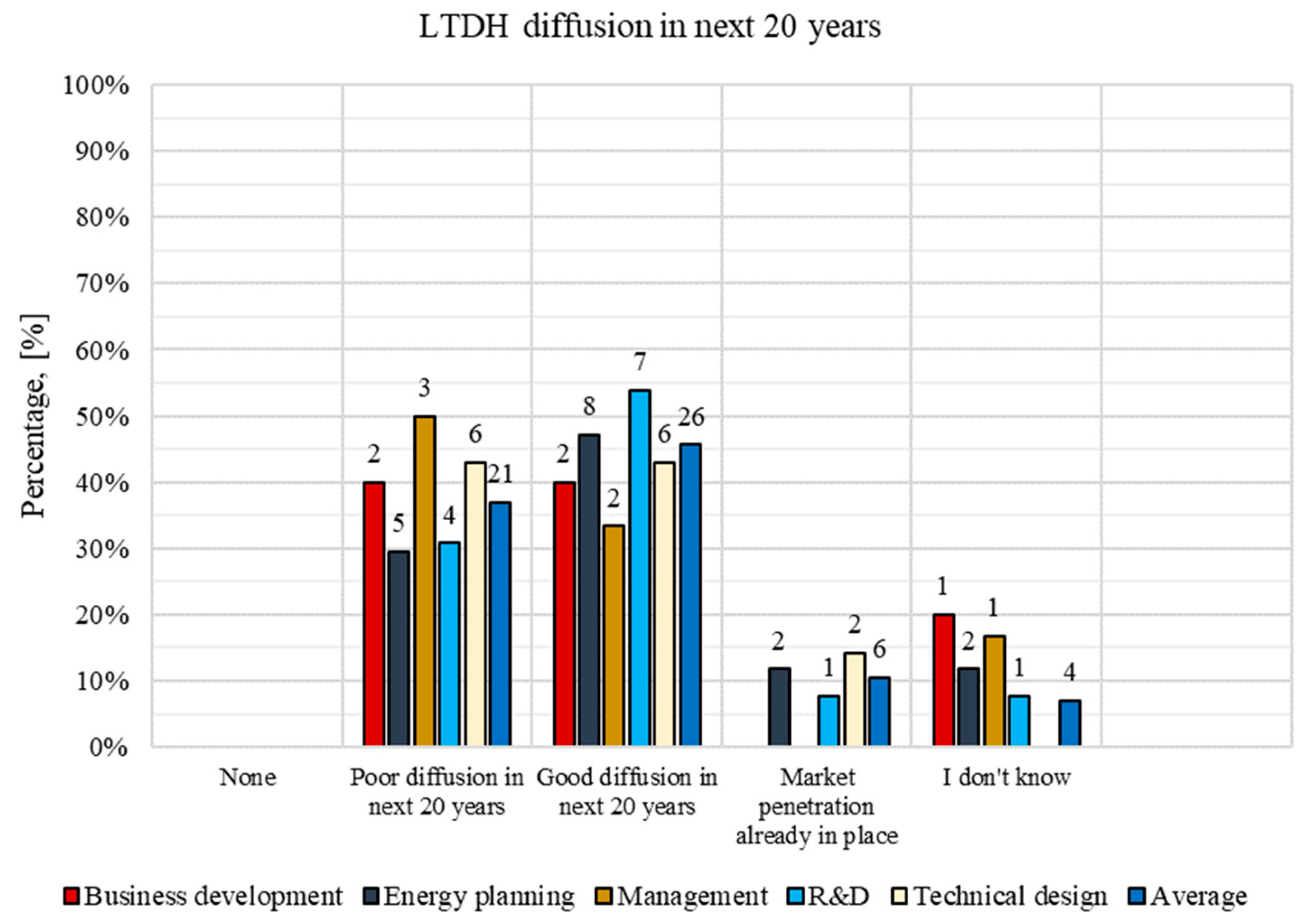
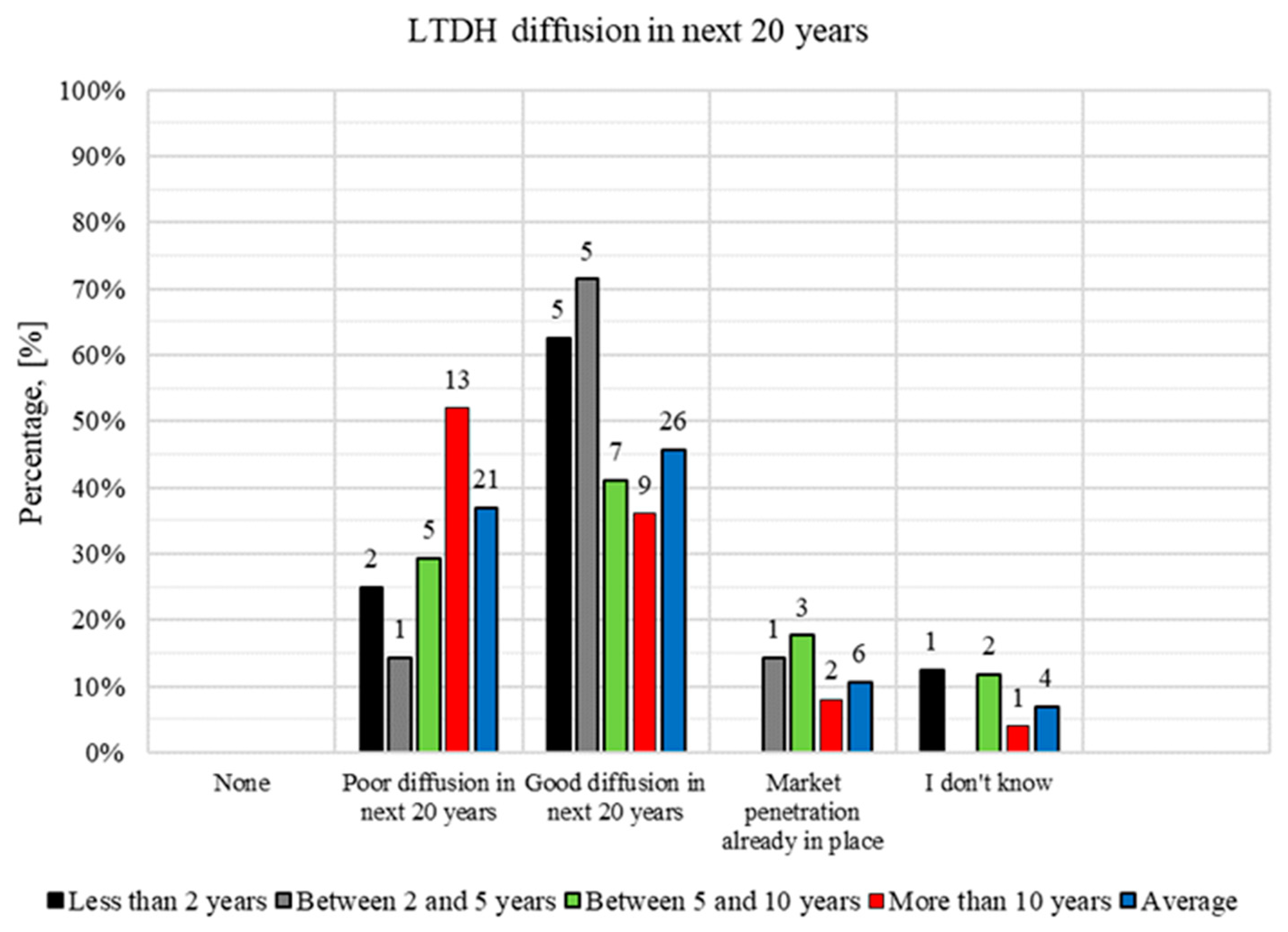
| DH Association Invited to the Survey | Country | Positively Answered to the Invitation |
|---|---|---|
| Associazione Italiana Riscaldamento Urbano (AIRU) | Italy | X |
| Associazione Svizzera di Teleriscaldamento (AST) | Switzerland | X |
| Finnish District Heating and Cooling Association | Finland | X |
| AGFW | Germany | X |
| UK District Energy Association | UK | X |
| Polish District Heating | Poland | |
| Hellenic Association for Cogeneration of Heat & Power | Greece | |
| Norsk Fjernvarme | Norway | |
| Japan Heat Supply Business Association | Japan | |
| China District Heating Association | China | |
| Center for Energy Efficiency | Russia | |
| Euroheat & Power | NA (*) | X |
| International District Energy Association | NA (*) | X |
| Asia Pacific Urban Energy Association | NA (*) |
| Is LTDH a Known Concept? | Italy | Other Countries |
|---|---|---|
| Yes | 42 | 33 |
| No | 2 | 0 |
© 2020 by the authors. Licensee MDPI, Basel, Switzerland. This article is an open access article distributed under the terms and conditions of the Creative Commons Attribution (CC BY) license (http://creativecommons.org/licenses/by/4.0/).
Share and Cite
Guzzini, A.; Pellegrini, M.; Pelliconi, E.; Saccani, C. Low Temperature District Heating: An Expert Opinion Survey. Energies 2020, 13, 810. https://doi.org/10.3390/en13040810
Guzzini A, Pellegrini M, Pelliconi E, Saccani C. Low Temperature District Heating: An Expert Opinion Survey. Energies. 2020; 13(4):810. https://doi.org/10.3390/en13040810
Chicago/Turabian StyleGuzzini, Alessandro, Marco Pellegrini, Edoardo Pelliconi, and Cesare Saccani. 2020. "Low Temperature District Heating: An Expert Opinion Survey" Energies 13, no. 4: 810. https://doi.org/10.3390/en13040810
APA StyleGuzzini, A., Pellegrini, M., Pelliconi, E., & Saccani, C. (2020). Low Temperature District Heating: An Expert Opinion Survey. Energies, 13(4), 810. https://doi.org/10.3390/en13040810







